Eco Park Plants
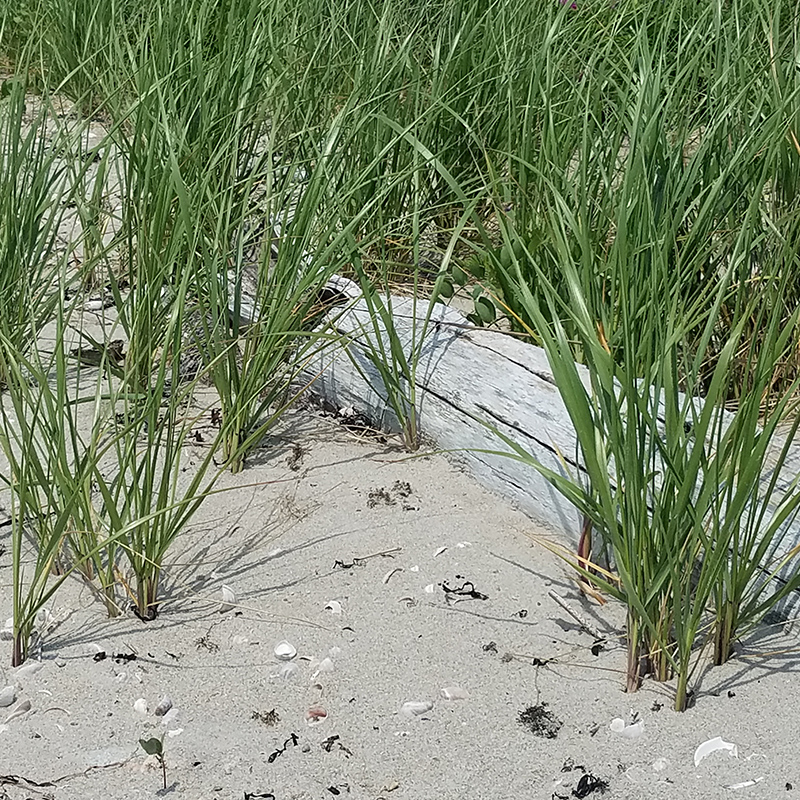
American beachgrass is a species of perennial grass native to eastern North America, where it grows on sand dunes along the Atlantic Ocean. It thrives under conditions of shifting sand, sand burial, and high winds; it is a dune-building grass that builds the first line of sand dunes along the coast. Beachgrass is less vigorous in stabilized sand and is only infrequently found further inland than the coastal foredunes. It is often planted in dune restoration projects. American beachgrass produces an extensive rhizome system. The leaves have deeply furrowed upper surfaces and smooth undersides and grow 1 to 3 feet tall. The plant’s inflorescence is a spike-like panicle that can reach 10 inches long; The spikelet is single-flowered. A seed head appears in late July or August.

Symphyotrichum oblongifolium, commonly called aromatic aster, is a bushy, stiff, compact, low-growing plant with hairy stems. Typically grows 1-2feet (infrequently to 3′) tall and features small, daisy-like flowers that are 1-inch across) with violet blue rays and yellow center disks. Long bloom period that lasts into late fall. Rigid, toothless, oblong, blue-green leaves to 4-inches long are, as the common name suggests, fragrant when crushed. Attractive to butterflies.
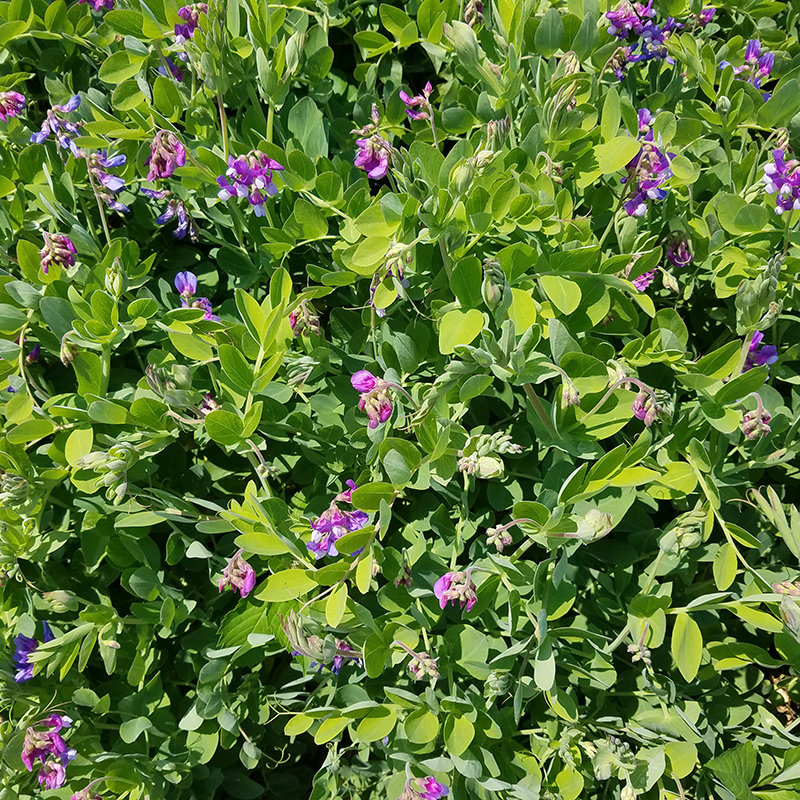
Beach peas are herbaceous perennial plants found on sandy coasts along much of New England. During the summer, these plants produce showy purple pea-like flowers. The leaves are pinnately compound with 3-5 pairs of smooth oval leaflets that are each 1 to 2 inches long, about half as wide and narrowed at both ends. When mature, the leaves will be green. Stems are angled.
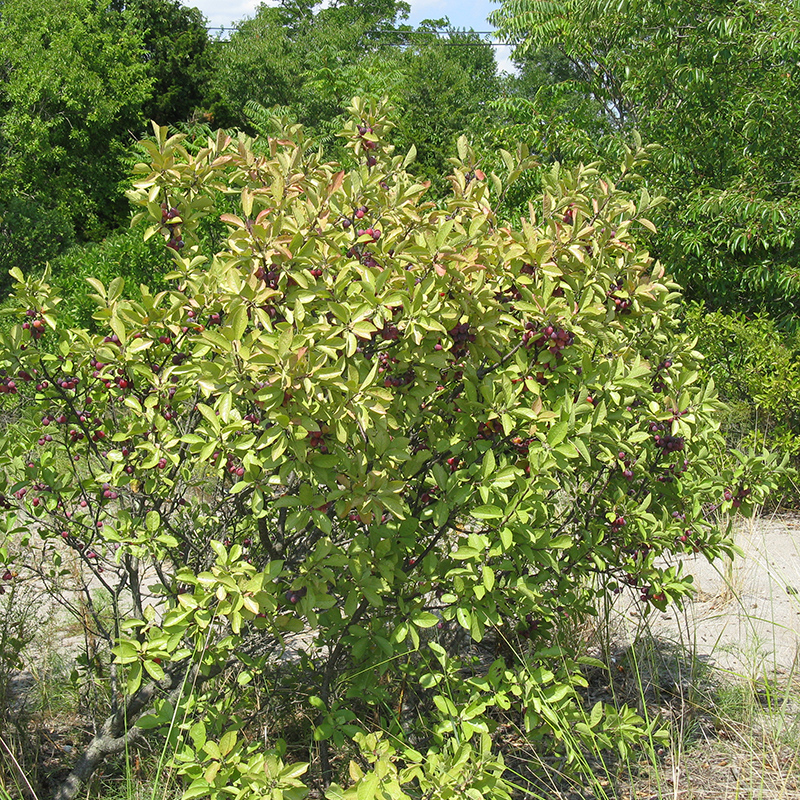
Beach plum is a rounded, dense, suckering shrub growing 6 ft. tall or more. White, single or double flowers occur in small clusters before the dark-green, glossy leaves. Fruits are dull purple to crimson, ripening from Aug. to Oct.
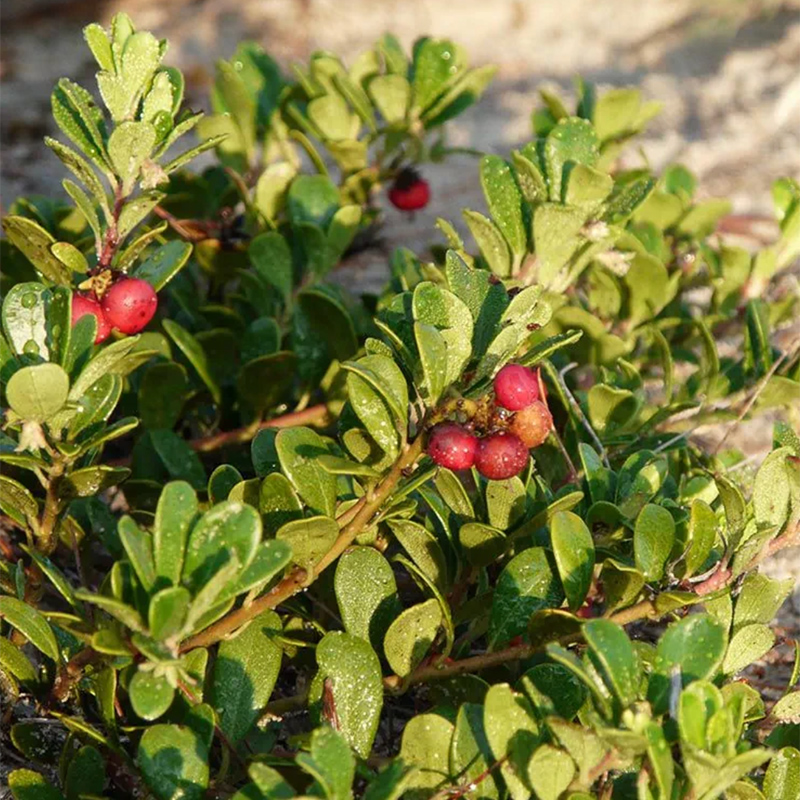
Extremely hardy, Bearberry forms an attractive dense groundcover in situations where few other plants can survive. Spreading gradually by surface rhizomes to form a mat, it grows naturally near sandy beaches. Bearberry is a trailing sub-shrub and less than one foot tall. A single plant can form a bushy, dense mat, 6-12 inches high and spreading 3-6 feet. The glossy dark green foliage of Bearberry is somewhat evergreen – turning a purplish bronze color in the winter and greening up again in the spring. Dainty lantern-shaped white-to-pink flowers appear in mid-spring, and last for several weeks. Perfect for rock gardens, it looks great trailing over a garden wall. The bright red berries that follow are eaten by birds and small mammals, while the plant itself is deer resistant. Bearberry is a host plant for several butterfly species including Hoary Elfin, Brown Elfin and Freija Fritillary. Once established Bearberry is a highly drought tolerant plant.

Black rush is a perennial plant that grows on tide lines and along waterways from vigorous rhizomes forming small upright stands just over 1 foot tall. It provides habitat for amphibians and various wetland birds, as well as a spawning ground for some fish species.
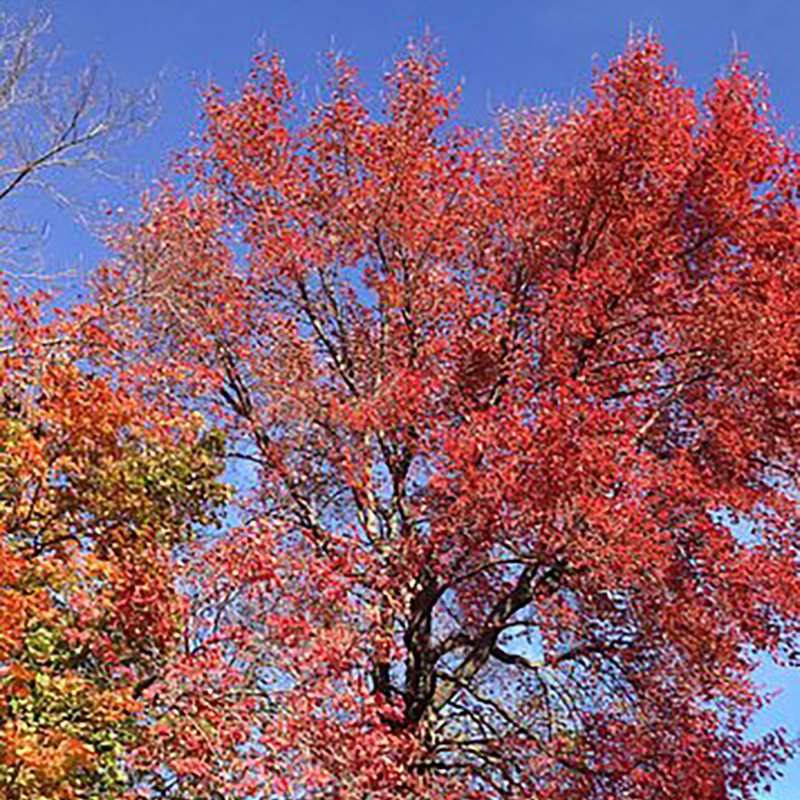
An attractive, variable-shaped deciduous tree, Black Tupelo grows 30-60 ft with horizontally spreading branches. Smooth, waxy, dark-green summer foliage changes to fluorescent yellow, orange, scarlet and purple in fall. Berries are small and blue.The juicy fruit is consumed by many birds and mammals. is a major source of wild honey in many areas within its range.

Black Eyed Susan (Rudbeckia hirta) is an upright plant that grows 12–39 in tall by 12–18 in wide. It has alternate, mostly basal leaves covered by coarse hair with stout branching stems and daisy-like, composite flower heads appearing in late summer and early autumn. In the species, the flowers are up to 4 inches in diameter, with yellow ray florets circling conspicuous brown or black, dome-shaped cones of many small disc florets. The late-season seed heads attract finches and other birds. Butterflies are attracted to Rudbeckia hirta. It is a larval host to the bordered patch, gorgone checkerspot, and silvery checkerspot species, which is listed as a species of special concern in Connecticut. Dragonflies, voracious eaters of mosquitoes, are attracted by the tiny pollinators of these flowers.
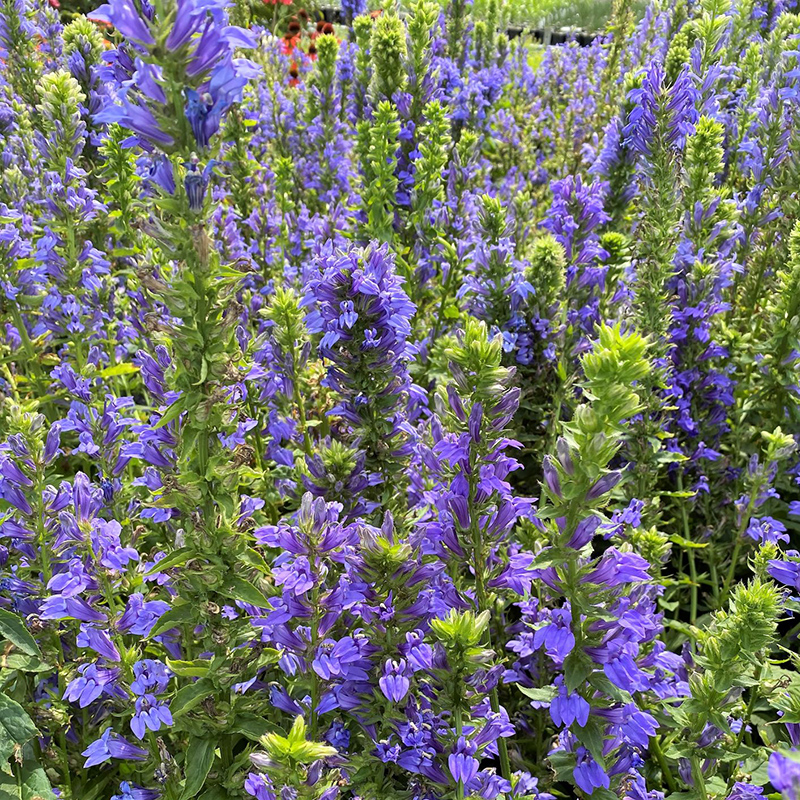
Growing up to 4 feet tall, Lobelia siphilitica has a single ridged, unbranched stem, which is smooth or sparsely hairy. Leaves are hairless or scarcely hairy and vary in shape from elliptical to lance-like, slightly narrowing at the base. They are about 2 inches wide and 2-6 in length. Leaves are alternately attached to the stem with no leaf stalk. The root system is a central taproot that occasionally produces basal offshoots. The plant produces a spike of flowers in the late summer. Although self-compatible, a flower is unable to offer pollen to itself, and it must be pollinated by insects, primarily bumblebees. Bees use the lower three fused petals as a landing pad. A bee of correct weight will depress these petals on its way to the flower’s nectar; this lowers the stigma, wiping it against the bee’s back.

Rising 2-4 ft. high from a woody base, blue wild indigo is a bushy, robust perennial. Flowers are blue-purple and pea-like, congested in dense, upright, terminal spikes, 4-16 in. long. Leaves are divided into three leaflets. In late fall, the plant turns silvery-gray, sometimes breaking off at ground level and tumbling about in the wind. Like other members of the pea family, this plant requires the presence of microorganisms that inhabit nodules on the plant’s root system and produce nitrogen compounds necessary for the plant’s survival.
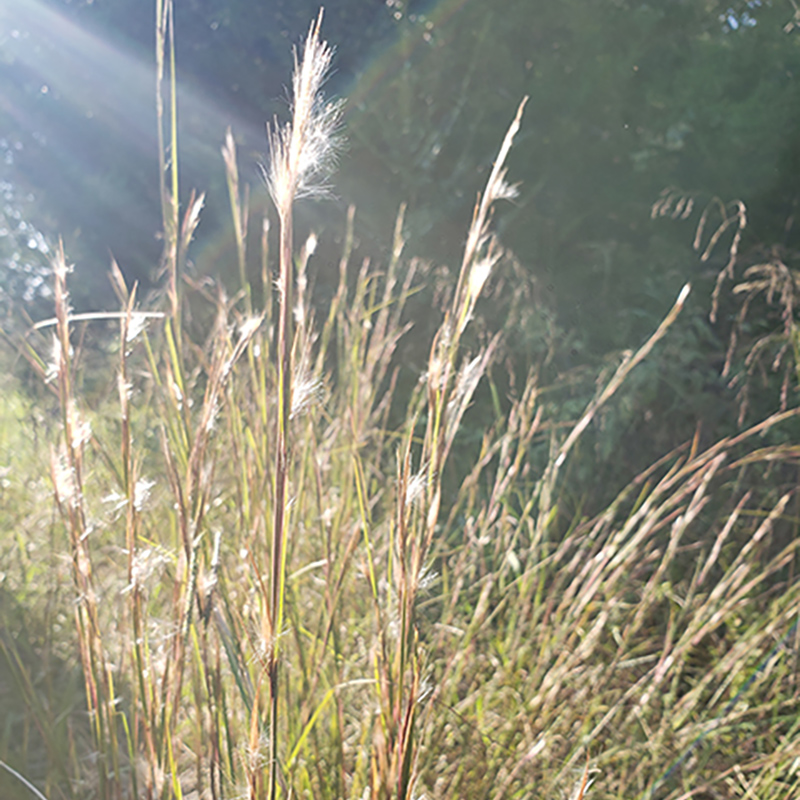
Broomsedge is a slender bunchgrass with an upright, vase-shaped habit and medium green leaves. It has very dense fibrous roots that help to control erosion. The seeds of Broomsedge are evenly distributed along the 2-6 foot stems and are striking in fall and winter when the fine hairs of the expanded racemes catch the sunlight. The clump-forming, perennial grass turns a tawny brown in fall. This grass is very drought tolerant and can survive infertile soils. It provides nesting material and cover specifically for quail, turkeys, and other birds. Small birds use broomsedge seeds in the winter when other food is limited. It is a larval host for Poanes zabulon, the Skipper butterfly.
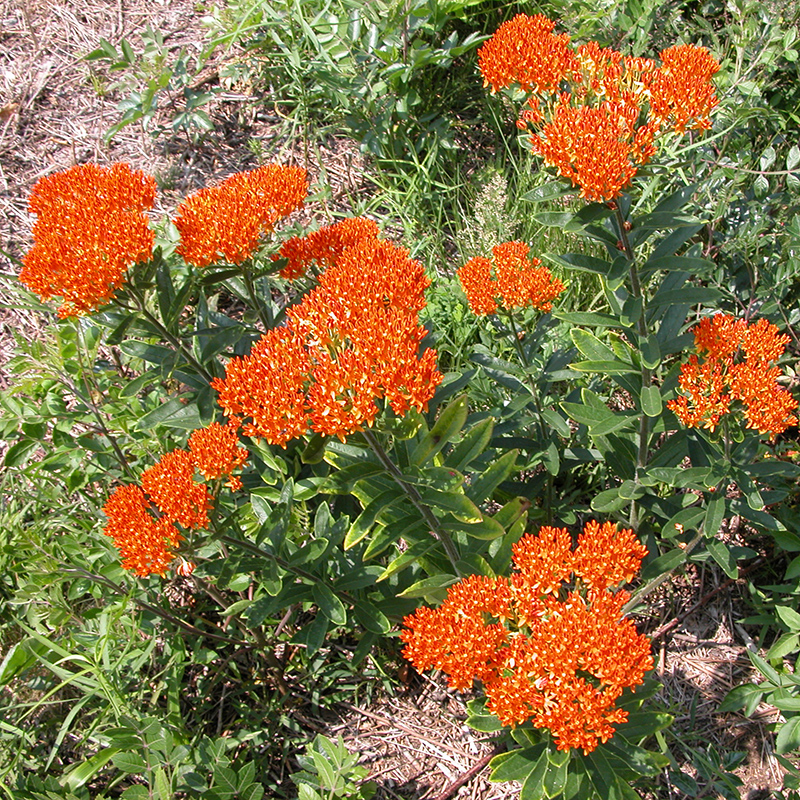
This bushy, 1 1/2-2 ft. perennial is prized for its large, flat-topped clusters of bright-orange flowers. The leaves are mostly alternate, 1.5-2.25 inches long, pointed, and smooth on the edge. The yellow-orange to bright orange flower clusters, 2-5 inches across, are at the top of the flowering stem. The abundance of stiff, lance-shaped foliage provides a dark green backdrop for the showy flower heads. Its brilliant flowers attract butterflies. Because its tough root was chewed by the Indians as a cure for pleurisy and other pulmonary ailments, Butterfly Weed was given its other common name, Pleurisy Root.

Canada germander is a robust perennial plant with a fibrous root system, forming clumps up to 3 feet tall. The upright, squarish stems have small side branches and send out rhizomes at the base. The leaves are opposite, stemmed lower on the plant and unstemmed on the upper sections of the stalk. They are ovate or lanceolate, deeply veined, and coarsely toothed, up to 5 inches long and 2.5 inches wide. The terminal inflorescence is a raceme up to 8 inches long, containing numerous whitish or pale lilac-lipped flowers with large shelf-like lower lips. The plant is in bloom from about mid-June for about a month, blooming from the bottom of the raceme upward. The flowers have no scent. The fruits contain four roundish yellowish-brown seeds. Pollinators include bumblebees, honey bees, digger bees, cuckoo bees, and megachilid bees, and the flowers are also visited by flies and butterflies and occasionally by hummingbird moths and hummingbirds. The foliage is unappealing to grazing animals because of its bitter taste.

Common boneset grows up to 39 inches tall, with opposite, serrate leaves that clasp the stem, which is hairy. The plant produces dense clusters of tiny white flower heads held above the foliage. In herbal medicine, the plant is a diaphoretic, or an agent to cause sweating.
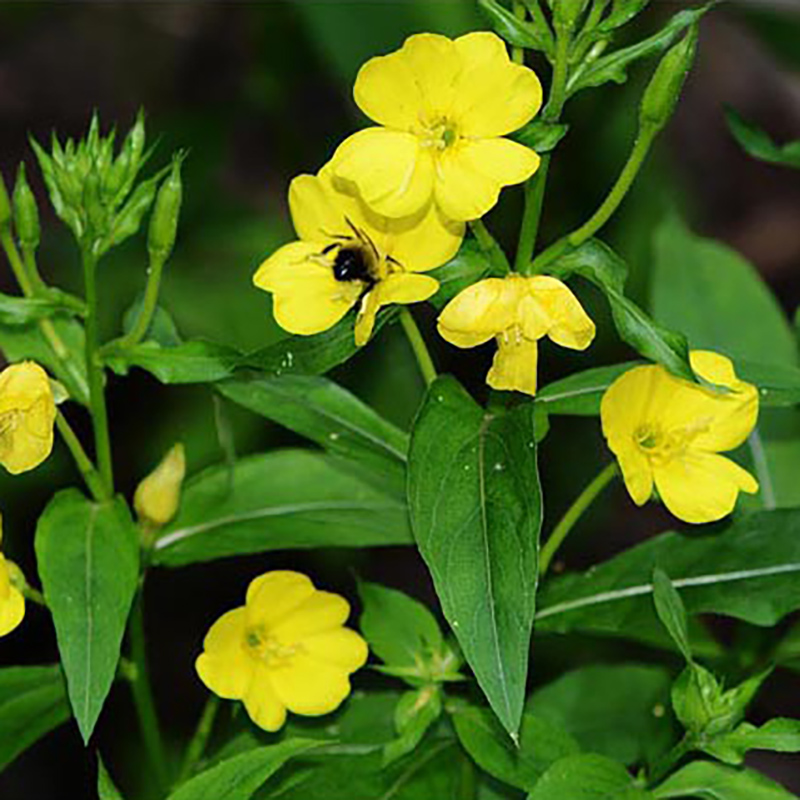
Common Evening Primrose is an erect, 2-6 ft. biennial with leafy, branched stems from a basal rosette. At the top of a leafy stalk bloom lemon-scented, large yellow flowers. Stem hairy, often purple-tinged. The bright yellow, four-petaled flowers are up to 2 inches across. The flowers of this night-flowering biennial open in the evening and close by noon. The plant takes 2 years to complete its life cycle, with basal leaves becoming established the first year, and flowering occurring the second. The roots are eaten by some wildlife, and the seeds are important as bird feed.

The Common Milkweed is the plant that most people associate with the word “milkweed.” It is a tall and conspicuous species that sometimes forms large clones. The flower clusters bear large balls of pink to purplish flowers that have an attractive fragrance. Follicle pods split open in the fall and early winter, dispensing wind-borne seeds. The plant contains a chemical that, when absorbed by monarch butterfly larvae whose sole source of food is milkweed foliage, makes the larvae and adult butterflies toxic to birds and other predators.
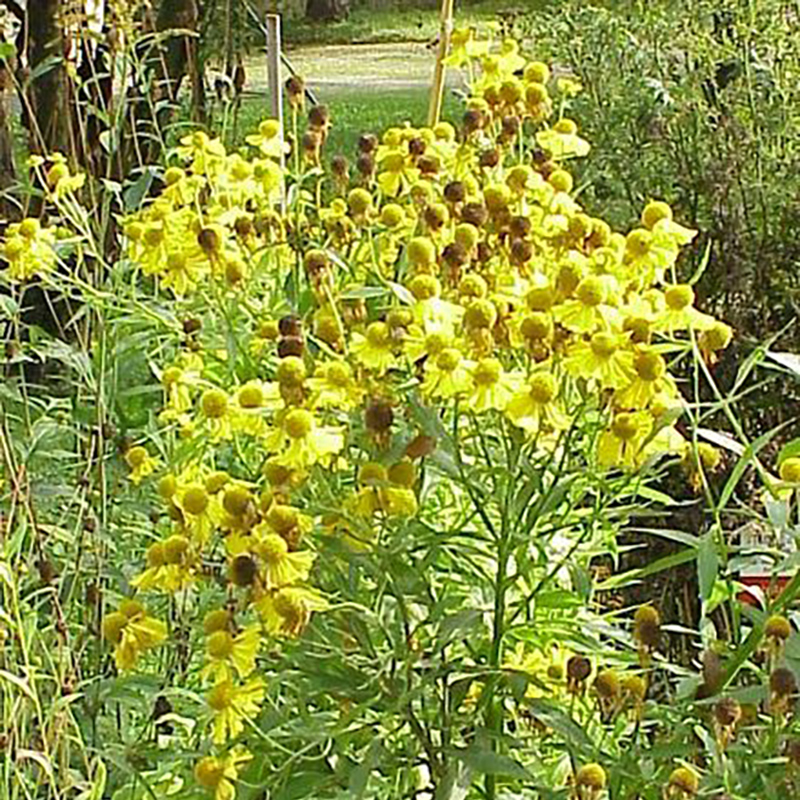
Common sneezeweed is a perennial herb up to 4 ft tall. In late summer and fall, one plant can produce as many as 100 yellow flower heads in a branching array. Each head has yellow 11–21 ray florets surrounding sometimes as many as 800 yellow disc florets. Leaves are dark green, alternate, and lance-shaped. The flowers attract various pollinators, including bees, butterflies, and wasps. Because the plant is pollinated by insects, not wind pollinated, it does not cause seasonal allergies or sneezing, despite its common name.
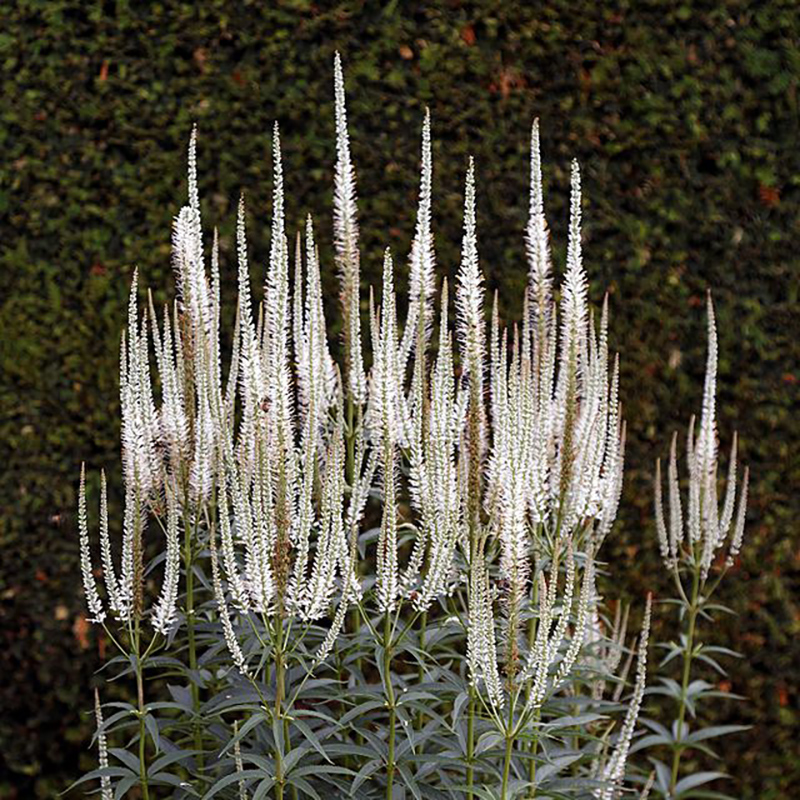
Veronicastrum virginicum, commonly called Culver’s root, is a large, erect, perennial that typically reaches 3-7 feet tall when in bloom. Dense, slender, 9-inch long spikes (racemes) of tiny, tube-like, white to pale blue flowers open from the top down in late spring to early summer atop strong, upright stems. Bloom can extend well into the summer. Smaller, branching, erect, lateral racemes give the plant a candelabra-like effect when in full bloom. It attracts butterflies.
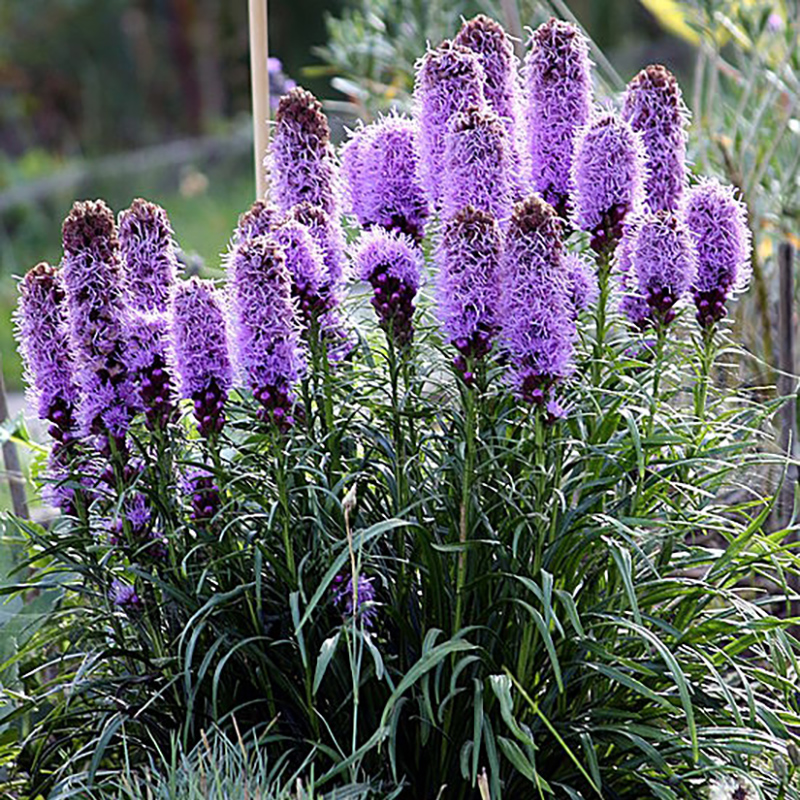
Dense blazing star have tall spikes of purple flowers resembling bottle brushes or feathers that grow 1–5 ft tall. Liatris spicata is excellent for attracting pollinators and beneficial insects. These include butterflies such as the monarch, tiger swallowtail, clouded sulfur, orange sulfur, gray hairstreak, Aphrodite fritillary, painted lady, red admiral, and wood nymphs. The flowers attract bumblebees, digger bees (Anthophorini), long-horned bees (Melissodes spp.), leaf-cutting bees (Megachile spp.), skippers, and birds, including hummingbirds Caterpillars of the rare flower moth (Schinia gloriosa) and liatris flower moth (Schinia sanguinea) feed on the flowers and seeds. Groundhogs, rabbits, and voles also eat the plants.
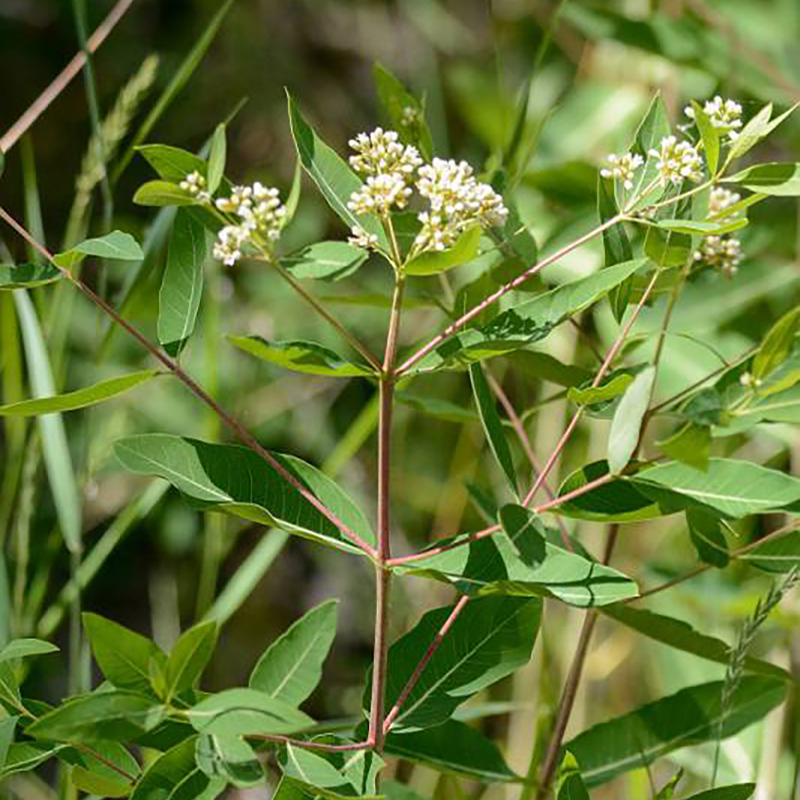
Dogbane grows up to 3 ft tall. The stems are reddish and contain a milky latex. The leaves are opposite, simple broad lanceolate, broad, and smooth on top with white hairs on the underside. It flowers from July to August, has large sepals, and a five-lobed white corolla. The flowers are hermaphrodite, with both male and female organs.The stalks of this plant have been used as a source of fiber to make bows, fire-bows, nets, tie down straps, hunting nets, fishing lines, bags, and clothing.It is poisonous to humans, dogs, cats, and horses. All parts of the plant are toxic and can cause cardiac arrest if ingested. Some Lepidoptera feed on this plant, such as the hummingbird moth.
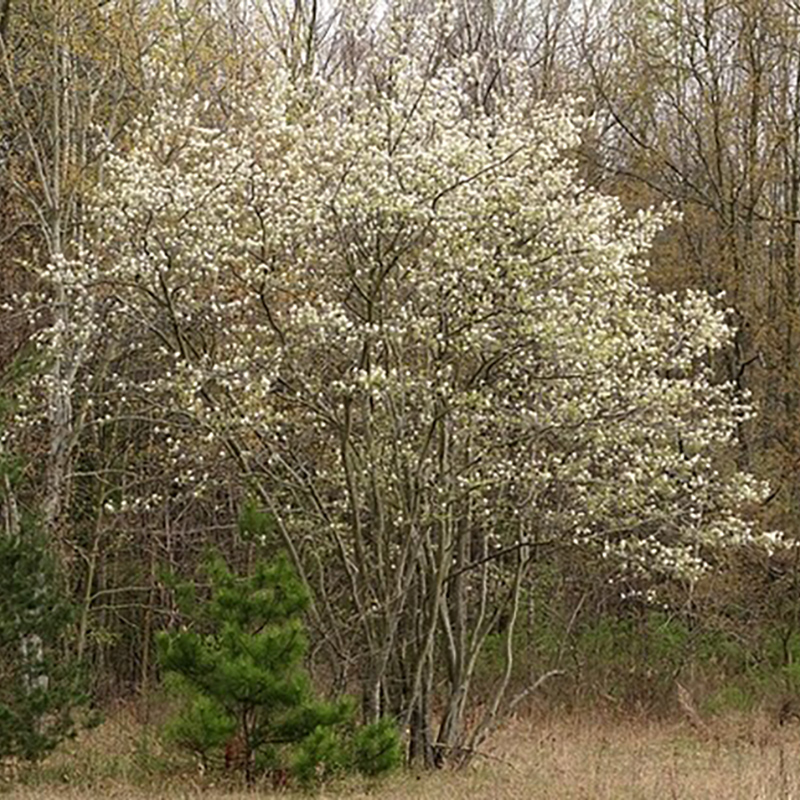
Downy Serviceberry gets its common name from the velvety, downy-hairy undersides of its leaves. The berries produced in early summer are eaten by over 40 species of birds and many mammals. The seeds benefit from being scarified during the digestion process.

Solidago juncea is a perennial herb up to 4 feet tall, that spreads by underground rhizomes. Leaves around the base of the plant can be as much as 1 foot long, the leaves getting smaller higher up on the stem. One plant can produce as many as 450 small yellow flower heads. Early Goldenrod is named because it is one of the earliest blooming goldenrods and tends to bloom from July to August. Bees and butterflies are attracted to this plant.

Eastern Red Cedar is a pioneer species, meaning that it is one of the first trees to repopulate disturbed sites. It is unusually long lived among pioneer species, with the potential to live over 900 years. The tree is extremely tolerant of drought due to its extensive, fibrous root system and reduced leaf area. The juniper berry is produces is an important winter food for many birds, which disperse the wingless seeds.

Eastern Serviceberry/Shadbush is a deciduous, small tree that flowers in the early spring. Its height ranges from 6 to 20 feet. The leaves are subtly serrated and about 1+1⁄2 to 2+1⁄2 inches in length and they have a simple alternate pattern. The fruit is pome-like and is less than 1 inch in both width and length. The fruits are a food source for many different species of birds and small mammals including cardinals, woodpeckers, robins, orioles, chipmunks, and squirrels.

False sunflower is a rhizomatous herbaceous perennial growing 16–59 in tall. The toothed leaf blades are oval to triangular or lance-shaped and may be smooth, hairy, or rough in texture. The flowers are produced from midsummer to early autumn. The inflorescence contains one to many composite flowerheads. Each head contains yellow ray florets, which are generally 1⁄2 in long. The rays are fertile, having a small forked pistil at the base; this distinguishes them from true sunflowers. At the center are many yellow to brownish disc florets.
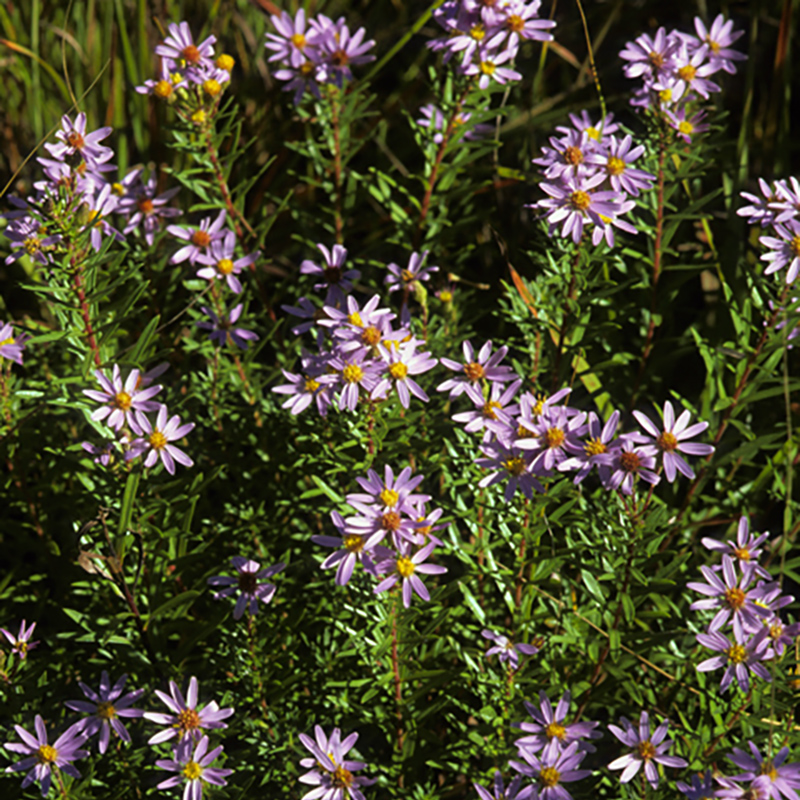
Flax-leaved aster has a stiff, leafy stalk that is terminated by several flower heads with blue ray flowers and yellow center disc flowers that turn bronzy. Numerous short stems form a mound of flowers in colors ranging from deepest lavender to pinks and whites. Its flowers attract several bee species, as well as butterflies.
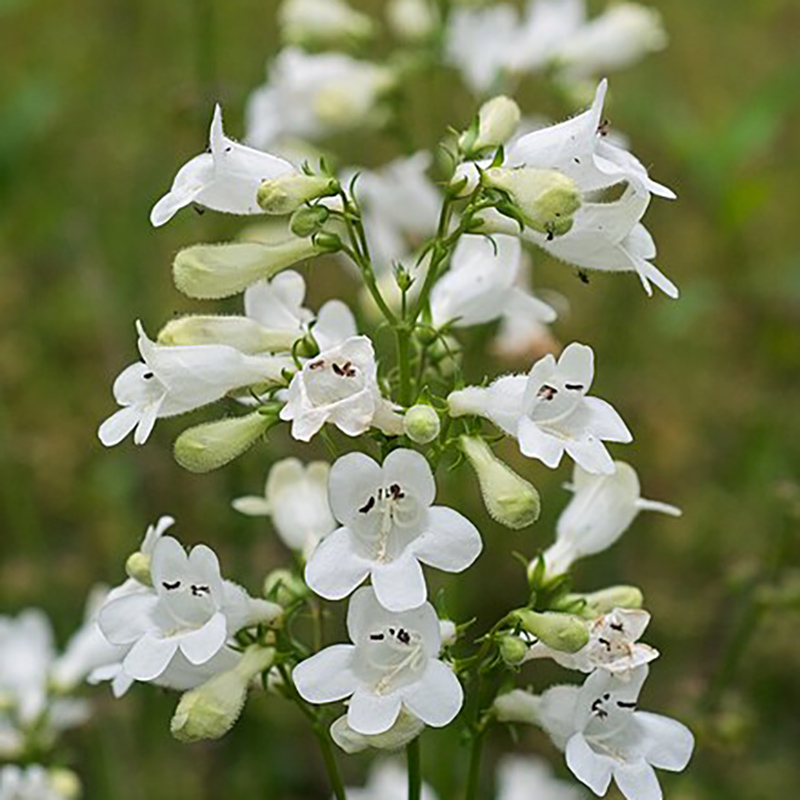
Penstemon digitalis is a glabrous 3 to 5-foot tall herbaceous plant with opposite, shiny green, simple leaves, on slender, purple stems. The leaves are up to 5 inches long. While upright, the stems average anywhere from 2 to 3 feet tall. The flowering panicle extends to almost one-third of the plant’s height and has pairs of branches that repeat with two flowers multiple times. The pedicels are one-fourth of an inch long and produce 1.25-inch long two-lipped tubular flowers over dark green foliage. The flowers have tiny white hairs on the outside of the tube. The plant has elliptic basal leaves and lance-shaped to oblong stem leaves. It blooms from late spring to early summer. The plant is known to attract butterflies, bees, and birds such as hummingbirds.
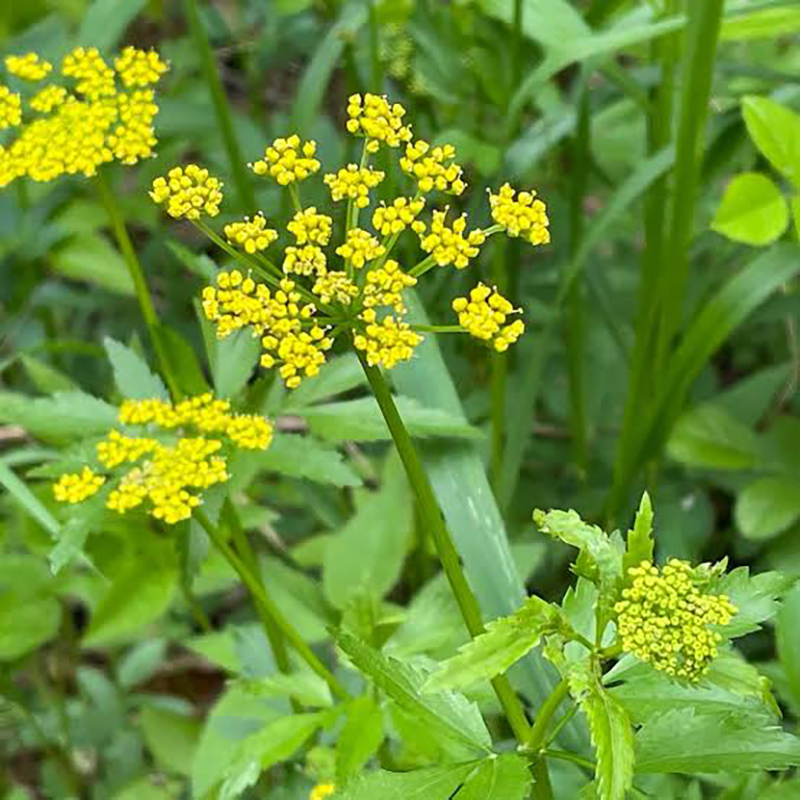
Zizia aurea (golden alexander) is a flowering herbaceous perennial plant of the carrot family Apiaceae. It grows to 16 to 30 inches tall but can sometimes grow taller. The leaves are 3 inches long and 2 inches wide. They are attached to the stems alternately. Each leaf is compound and odd-pinnate, with leaflets that are normally lanceolate or ovate with serrated edges. The root system consists of a dense cluster of coarse, fibrous roots. It blooms from May to June. Its flowers are yellow and grow in a flat-topped umbel at the top of the plant. Each flower is very small and has five sepals, five petals, and five stamens. Each flower produces a single tiny, oblong fruit (schizocarp) containing two seeds. In the fall, both the leaves and the fruit turn purple. It is a host plant for the caterpillars of the black swallowtail (Papilio polyxenes asterius) and Ozark swallowtail (Papilio joanae) butterflies. Females of the mining bee species Andrena ziziae are oligolectic on Zizia aurea — they eat only its pollen. Dozens of species of bees, flies, wasps, butterflies, and other insects visit the flowers of Zizia aurea for its nectar.
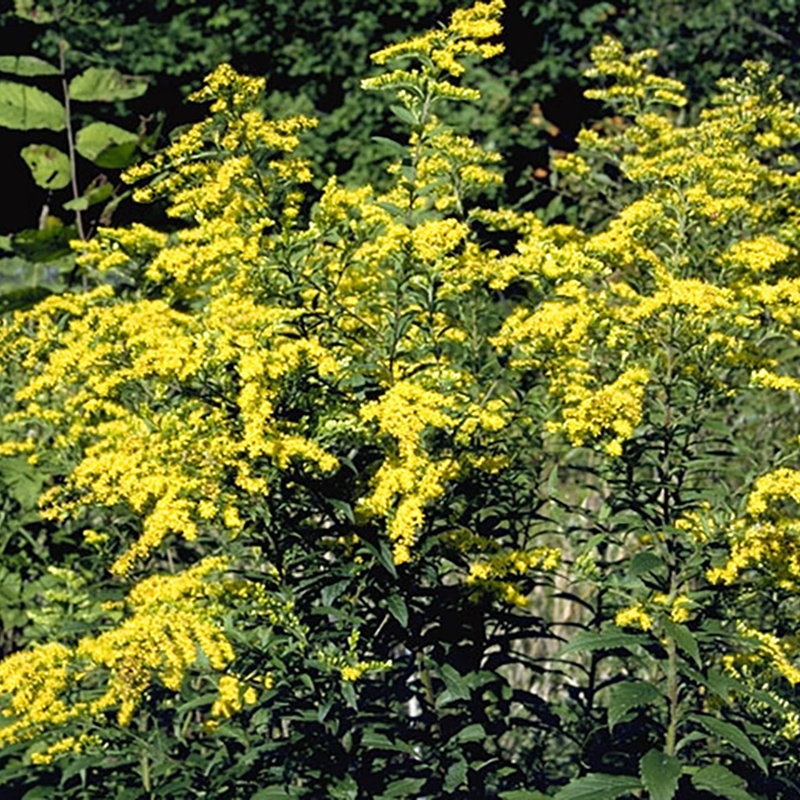
Slender-stemmed plant, 1 1/2 to 3 ft. tall. Thin, coarsely-toothed leaves. Flowers occur on the upper side of hairy stalks, which arch out and downward. Clumps of slender, gray-downy stems produce terminal, one-sided, yellow plumes that give the perennial a vase-shaped appearance. It attracts butterflies.
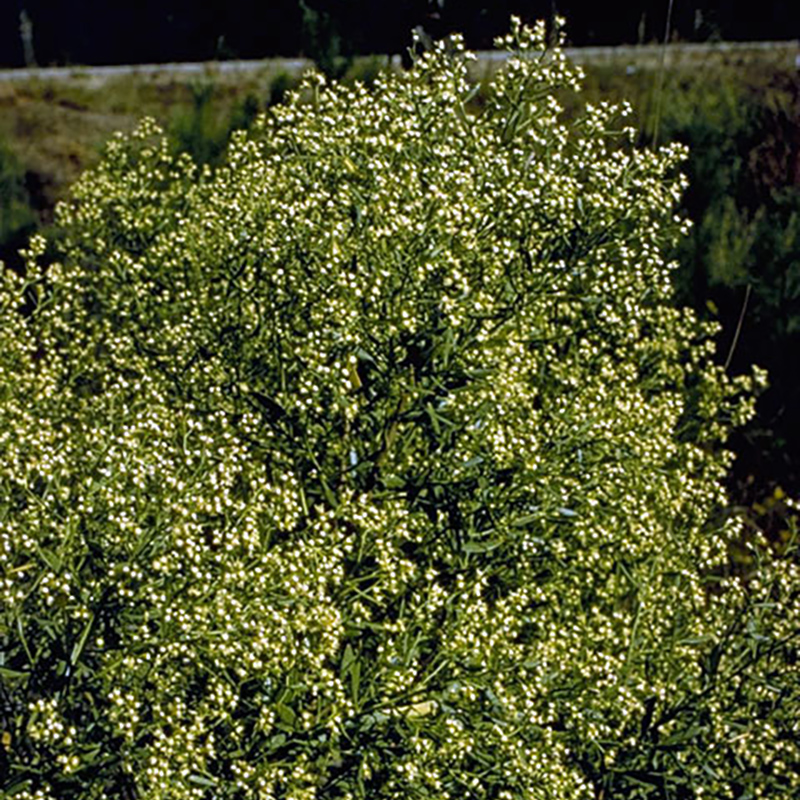
Groundsel bush or sea myrtle’s numerous branches from short trunks are covered densely with branchlets. The 6-12 ft. , deciduous shrub bears gray-green, somewhat lobed, oval leaves which are semi-persistent in the North. White to green flowers occur in small, dense, terminal clusters.Tolerant of saltwater spray, this ornamental is one of the few eastern shrubs suitable for planting near the ocean.
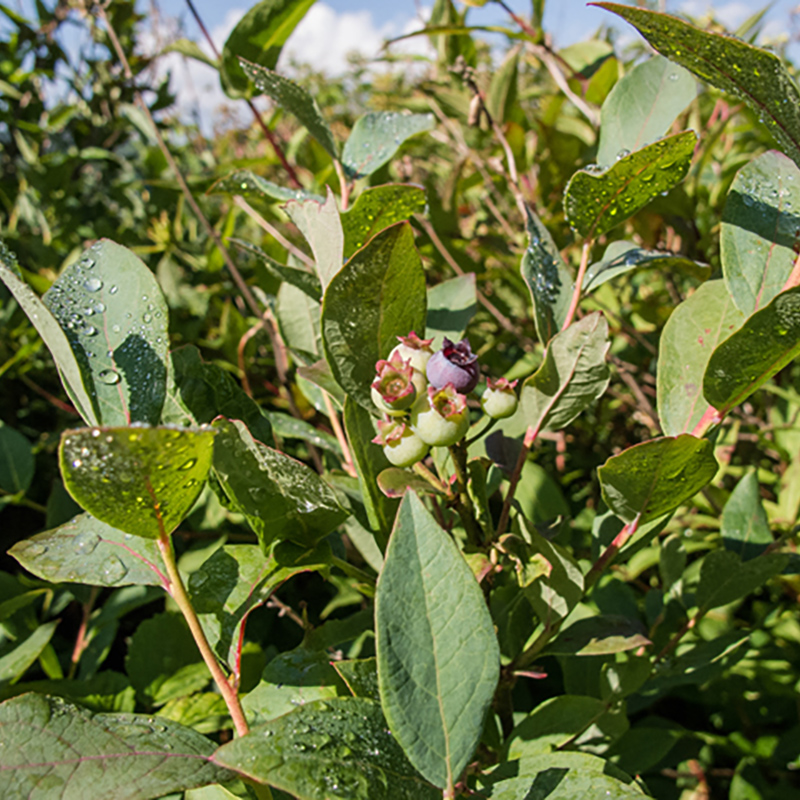
This blueberry species is usually a 6-12 ft. high and wide, deciduous shrub with numerous upright stems and twiggy branches forming a rounded, compact outline. Reddish-green spring leaves turn blue-green in summer and red, yellow, orange, and purple in fall. White or pink, bell-shaped flowers in drooping clusters are followed by edible, blue fruit. A multi-stemmed shrub with green, or often red, twigs and terminal clusters of small, urn-shaped white flowers. These plants are very important to wildlife. Its berries are relished by songbirds, game birds, and small mammals; the twigs and foliage are eaten by deer and rabbits. Because of their food value and spectacular red fall foliage, these shrubs are excellent for naturalized landscaping.
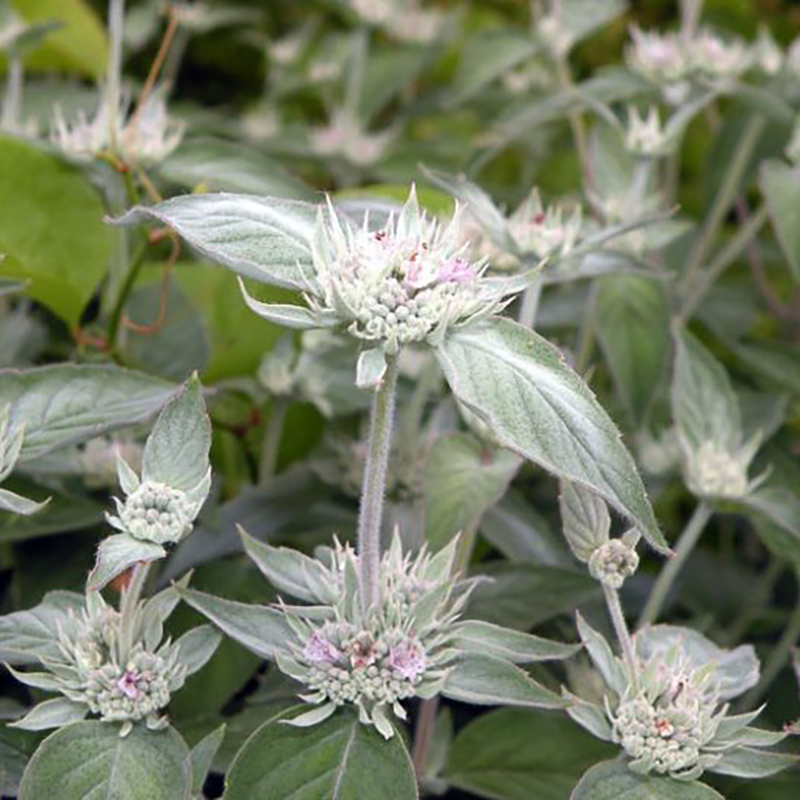
Pycnanthemum incanum is a stiff, erect, clump-forming aromatic perennial with opposite, ovate, toothed leaves to 3 in long. It grows to 2-3 ft tall. In mid to late summer, dense, rounded clusters of tiny, silvery-white, two-lipped flowers appear atop the stems. They bloom for about 6 weeks and continue until early fall. The flowers attract butterflies, moths, and other pollinators.

Little Bluestem is an ornamental bunchgrass with fine-textured foliage that forms very dense mounds 18-24 inches tall. Slender blue-green stems often reach 5 feet or more by September and become radiant mahogany-red with white, shining seed tufts in the fall. Color remains nearly all winter. Perennial clumps grow up to a foot in diameter. Wildlife use Little Bluestem to graze, as cover, for nesting, and eat its seeds. It attracts birds and butterflies and is a larval host for Ottoe Skipper, Indian Skipper, Crossline Skipper, Dusted Skipper, Cobweb butterfly, Dixie Skipper.
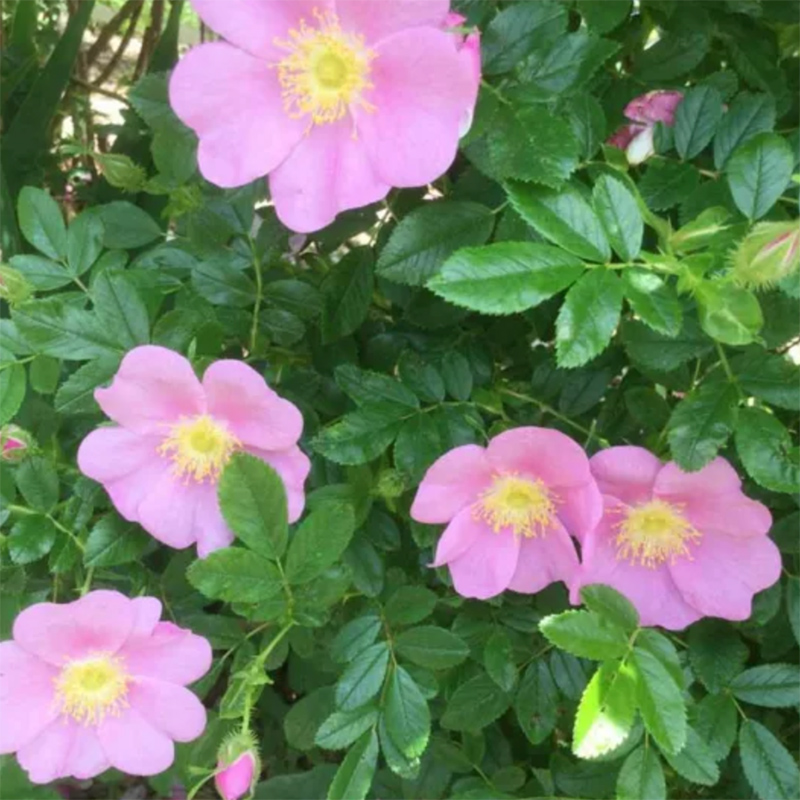
Rosa virginiana, commonly known as the Virginia rose or common wild rose, is a woody perennial in the rose family native to eastern North America, where it is the most common wild rose. It is deciduous, forming a suckering shrub up to 2 meters in height, though often less. The stems are covered in numerous hooked prickles. The leaves are pinnate, usually with between 7 and 9 glossy leaflets. The pink flowers are borne singly or in small clusters and appear over a long period in midsummer. The fruits are small, round, and bright red, rich in vitamin C, and edible, being both used to make jams and tea. The plant attracts birds, bees, butterflies, and hummingbirds.
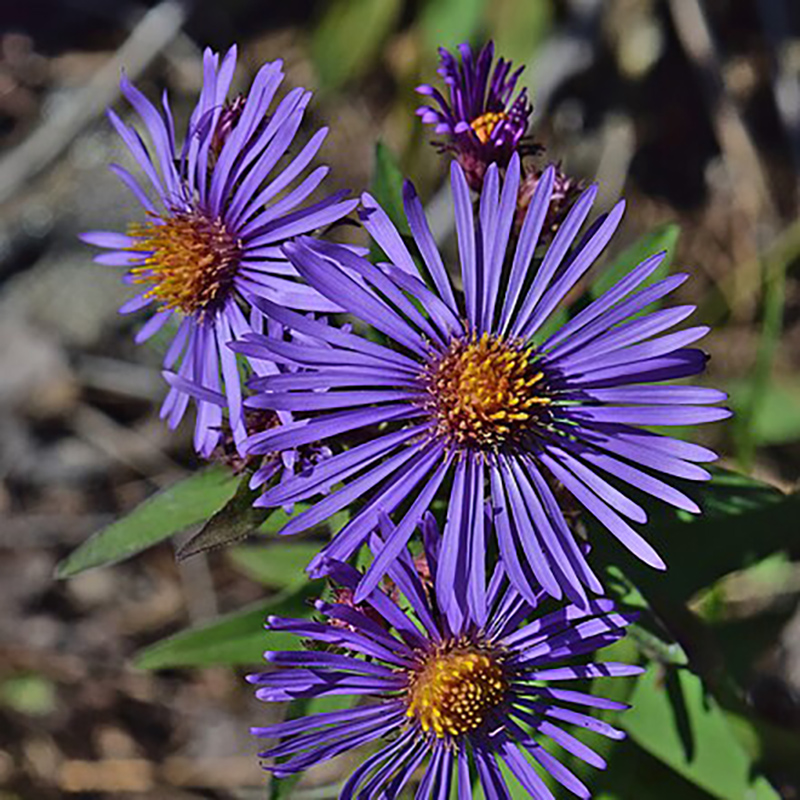
New England aster is a perennial, herbaceous plant usually between 1 and 4 ft tall and 2 to 3 ft wide. The purple flowers have up to 100 ray florets that surround the flower centers are composed of just as many tiny yellow disk florets. The plant grows naturally in clumps, with several erect stems emerging from a single point. The stems are stout, hairy, and mostly unbranched. The untoothed, lance-shaped leaves clasp the stem with earlobe-like appendages. The seeds and nectar of this species, which bloom from August to November, are important to a wide variety of animals, including birds, bees, and butterflies.
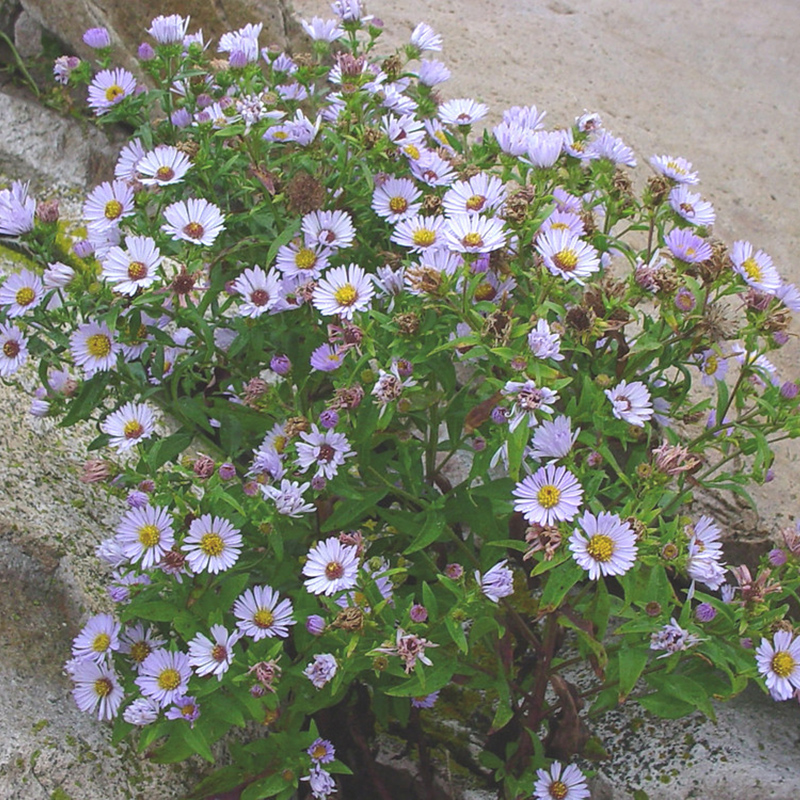
New York Aster is a native herbaceous perennial in the Asteraceae family that may grow 3 to 5 feet high. It is found growing in slightly brackish and tidal fresh marshes, occasionally borders of salt marshes and inland marshes, shrub marshes, shores and other moist areas. This plant requires well-drained soil and prefers sandy, loamy and clay soils. It has a low growing habit and blooms in the fall with fall bloom works numerous heads of purplish flowers with a yellow center.

New York ironweed is a tall, coarse, upright perennial that typically occurs in the wild in moist thickets, low areas, and along stream banks. It has numerous tiny, fluffy, deep purple composite flowers in loose, 3-4 inch-wide terminal clusters atop stiff, leafy stems typically growing 4-6 feet tall. Somewhat suggestive of Joe Pye weed, except leaves of ironweed are alternate. Blooms late summer into fall. Rough, pointed, serrate, lance-shaped leaves that are 6-8″ long. Flowers give way to rusty seed clusters. The source of the common name has been varyingly attributed to certain “iron-like” plant qualities, including the tough stems, the rusty-tinged color of fading flowers and the rusty colored seeds.
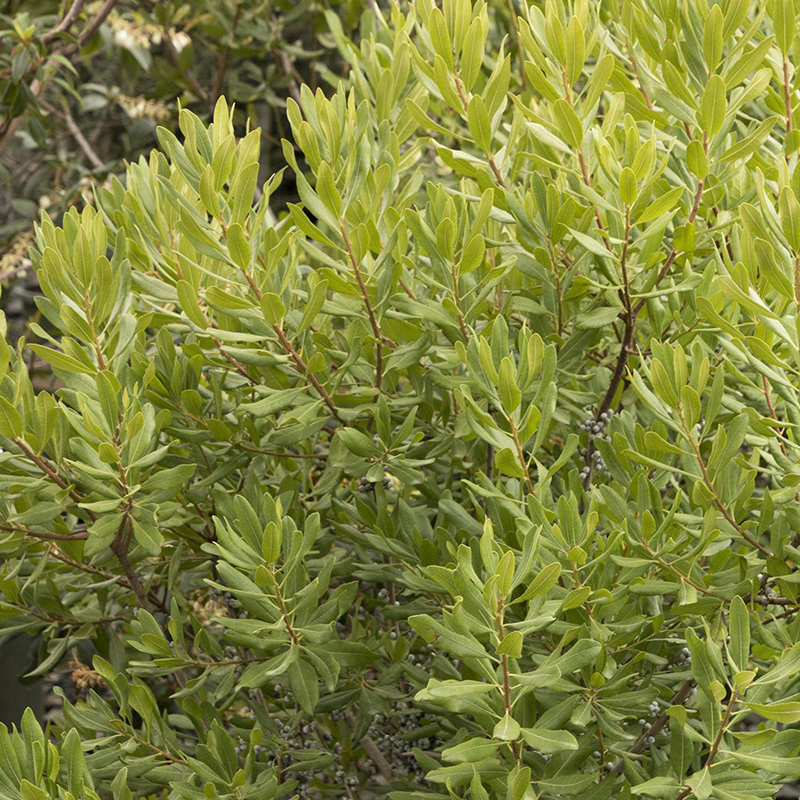
Fragrant, dense foliage on a compact form that can grow to 9 ft. tall, equal width. Leaves are sticky with a spicy scent when crushed. The fruit is a small wrinkled berry with a pale blue-purple waxy coating. They are an important food for yellow-rumped warblers. This species has root nodules containing nitrogen-fixing microorganisms, allowing it to grow in relatively poor soils.
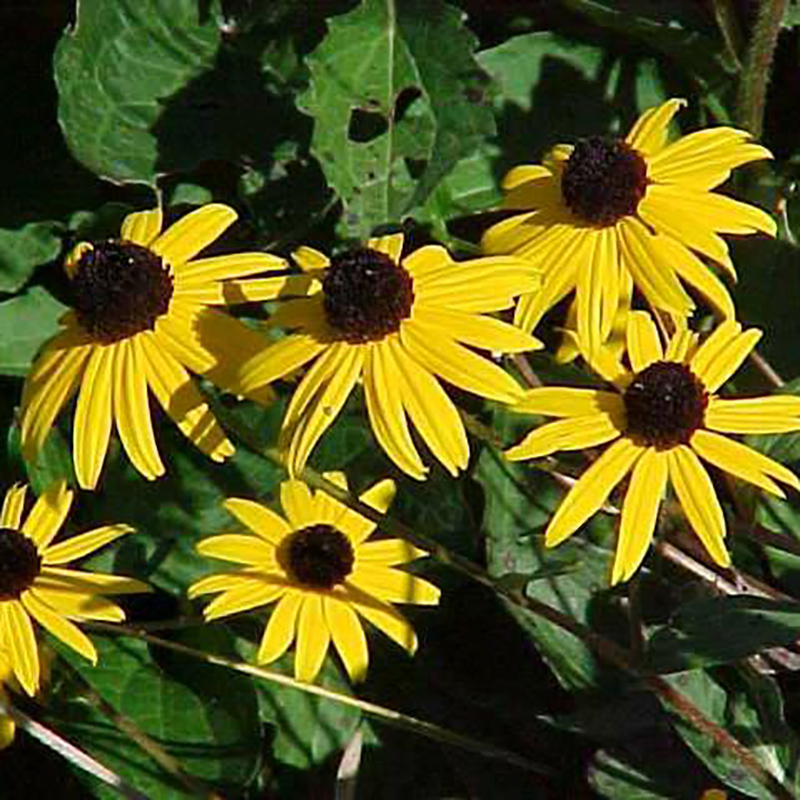
Rudbeckia fulgida is an herbaceous perennial that is upright, rhizomatous, clump-forming, free-blooming coneflower that typically grows to 3 ft tall, often forming colonies in the wild. Features daisy-like flowers up to 2.5″ across with yellow rays and brownish-purple center disks. Prolific bloom production over a long mid-summer to fall bloom period. Oblong to lanceolate, medium green foliage. The flowers attract butterflies and other insect pollinators. Birds eat the seeds.
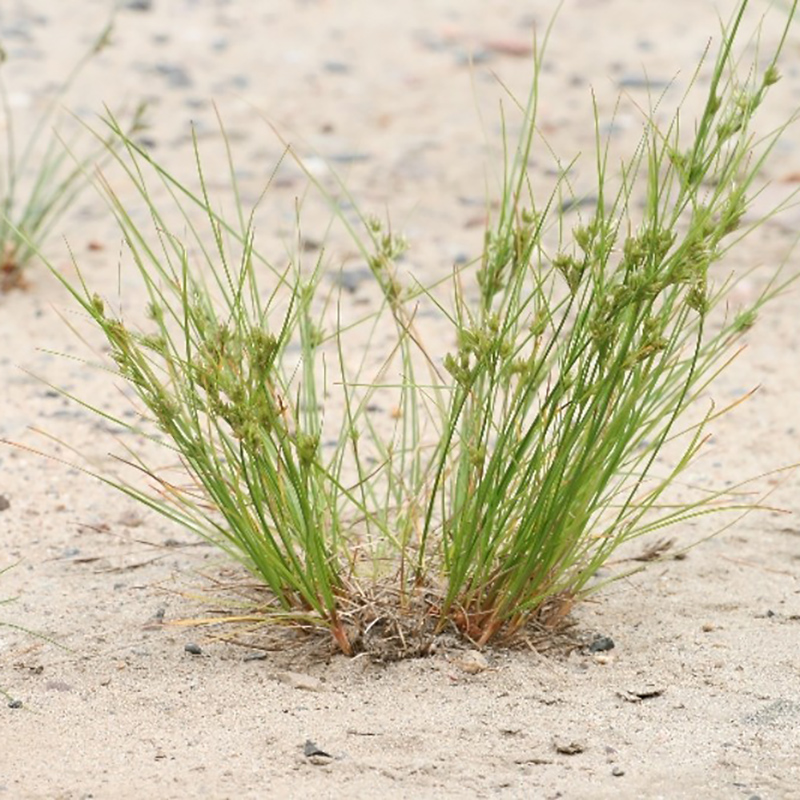
Path rush is found in the wild throughout North America. It grows to two feet tall. It has tough stems with medium green leaves that turn brown with frost. Tiny flowers are clustered at or near the stem tips and bloom from May to September.
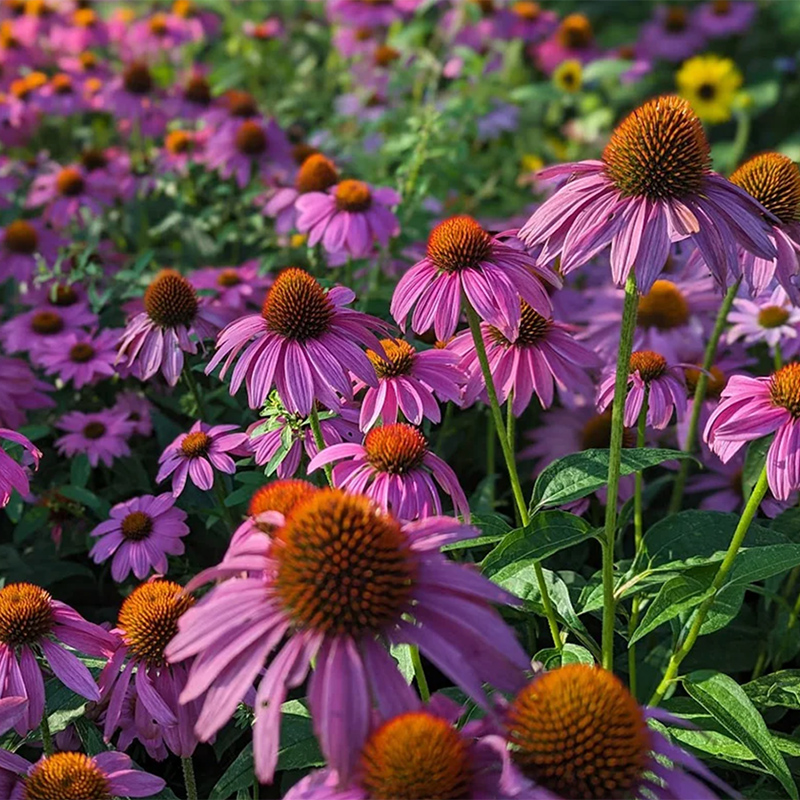
A perennial with smooth, 2-4 ft. stems. Rough, scattered leaves that become small toward the top of the stem. Long-lasting flowers occur singly atop the stems and have domed, purplish-brown, spiny centers and drooping, lavender rays.
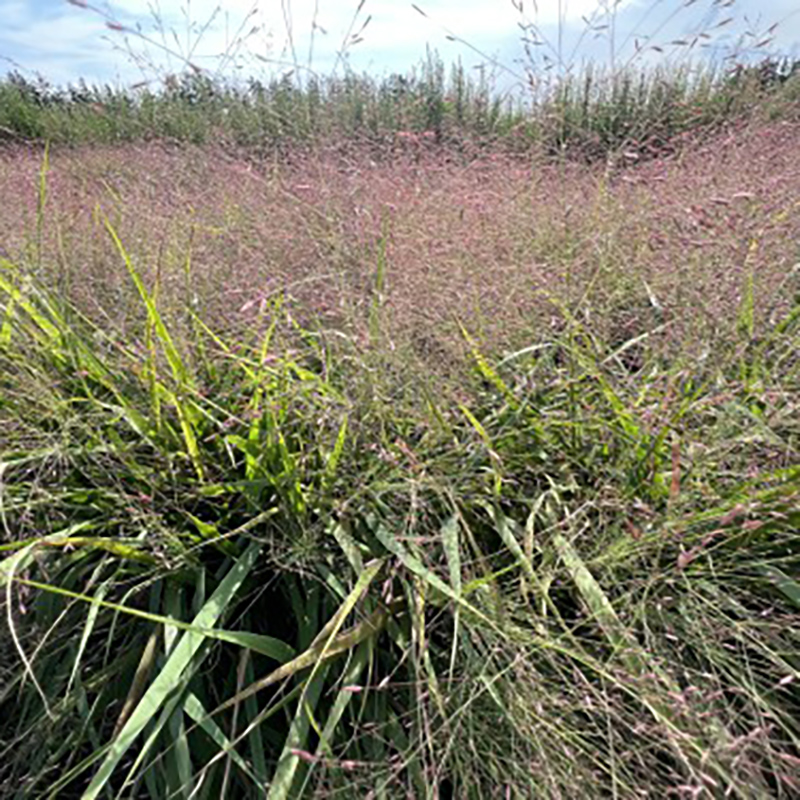
Commonly called purple love grass, Eragrostis spectabilis is a warm season bunchgrass that is native to sandy soils. Flat, coarse, mostly basal, green leaves (to 10″ long and 3/8″ wide) form a somewhat disorganized clump of foliage that typically rises to 10″ tall. Soft reddish-purple flowers in a loose, open inflorescence appear in August, forming an airy cloud that covers the grass clump and raises the overall height of the plant to 24″ tall. Flowers lose color and turn brown by October. As the seeds mature, the inflorescence usually detaches from the plant and blows along the ground like a tumbleweed distributing seed as it goes.
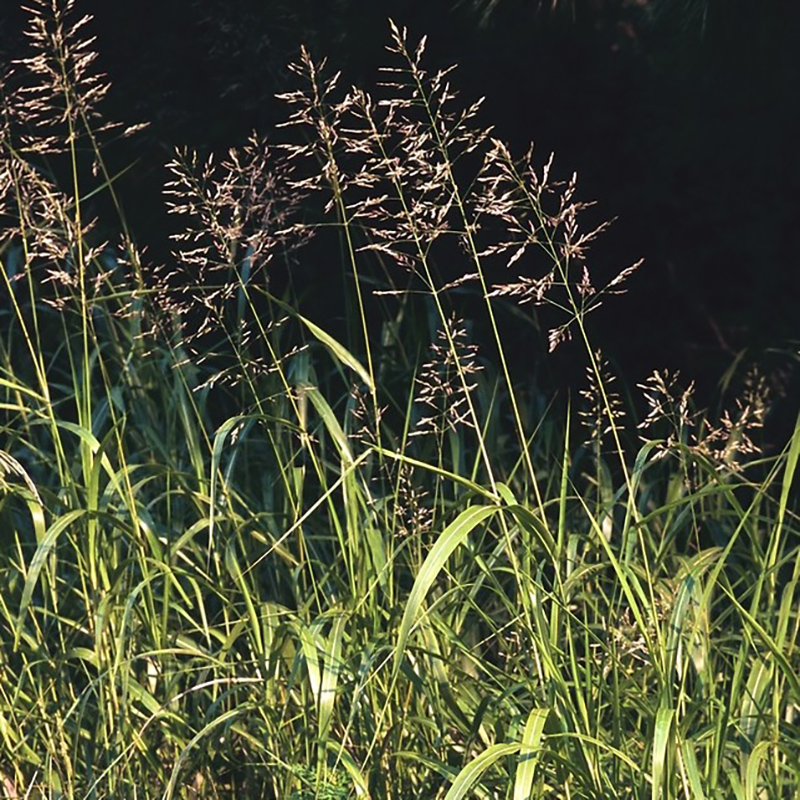
Purpletop is a large, robust perennial bunchgrass. The seeds are purple, giving the grass its common name. The seeds are also oily, leading to its other common name, “grease grass.” It reproduces by seed and tillers. It is a larval host to the common wood nymph, crossline skipper, little glassywing, and the Zabulon skipper.
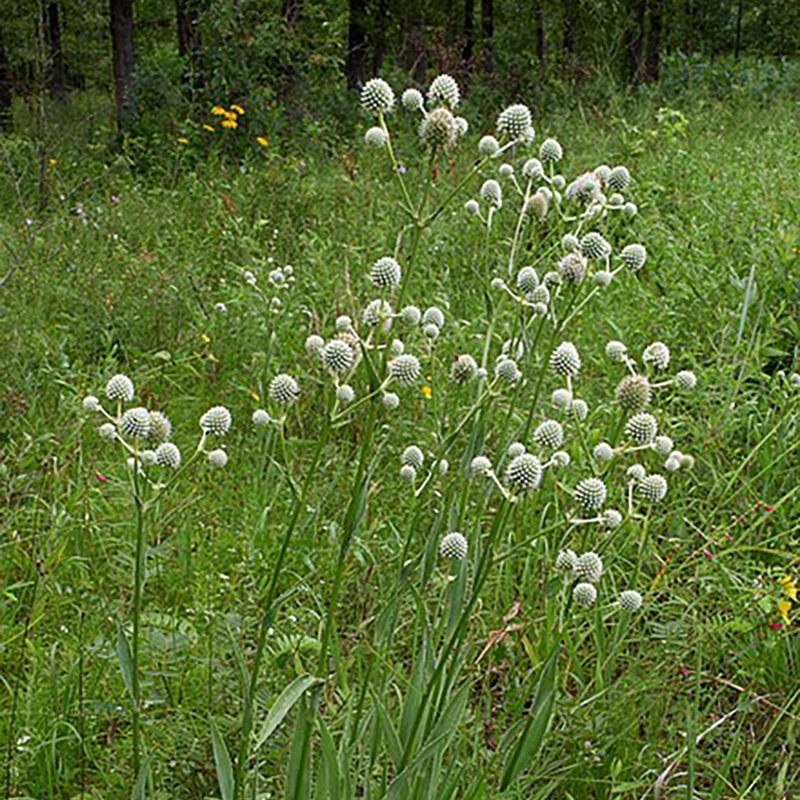
The plant’s leaves are stiff, long, and narrow with a sharp tip, 0–5 ft long but only 0.39–1.18 in broad. They are bluish-green and covered in a waxy coating. On the edges are regularly spaced bristles or spines. The root system consists of a central taproot surrounded by thick, fleshy, fibrous roots. It grows up to 5.9 ft tall, with 10–40 dense, ball-shaped umbels of flowers produced at the top of each stem. Each of these condensed umbels is 0.5–1 in in diameter, resembling flowerheads. Individual flowers in the umbels are small in diameter with greenish-white or bluish-white petals and a faint honey-like scent. Underneath each flower is a spiny green bract, and underneath each flower cluster is a small star-like rosette of spiny bracts. The flowers are produced in July and August. The common name “rattlesnake master” is attributed to early European pioneers erroneously believing the plant to be an antidote for rattlesnake venom based upon Native Americans’ various medicinal uses of the plant. The flowers attract many insects, including short and long-tongued bees, flies, beetles, and butterflies, but most numerous of all are wasps. It is a larval host to the rare rattlesnake-master borer moth (Papaipema eryngii).
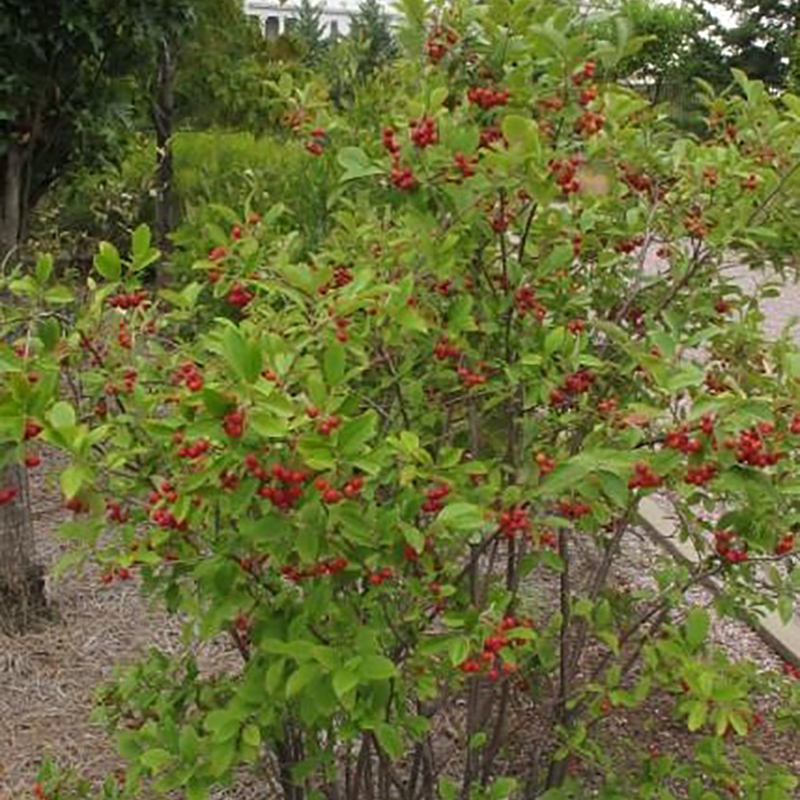
The Red Chokeberry is a multi-stemmed, deciduous shrub that has multi-season interest. Spring brings clusters of white to light pink flowers. The leaves are green and glossy throughout the summer and turn orangish-red or purple in the fall. Bright red pear-shaped berries appear in the fall and may persist through the winter. The bark is reddish-brown and adds interest to a winter garden.Its fruits are eaten by mammals and birds. Butterflies and pollinators are attracted to the flowers for nectar.

This is an erect, branching perennial, up to 3 ft. tall, well-known for its showy flowers. A nodding, red and yellow flower with upward spurred petals alternating with spreading, colored sepals and numerous yellow stamens hanging below the petals. The compound leaves are divided into round-lobed threes.This wildflower has drooping, bell-like flowers equipped with distinctly backward-pointing tubes. These tubes, or spurs, contain nectar that attracts long-tongued insects and hummingbirds especially adapted for reaching the sweet secretion.
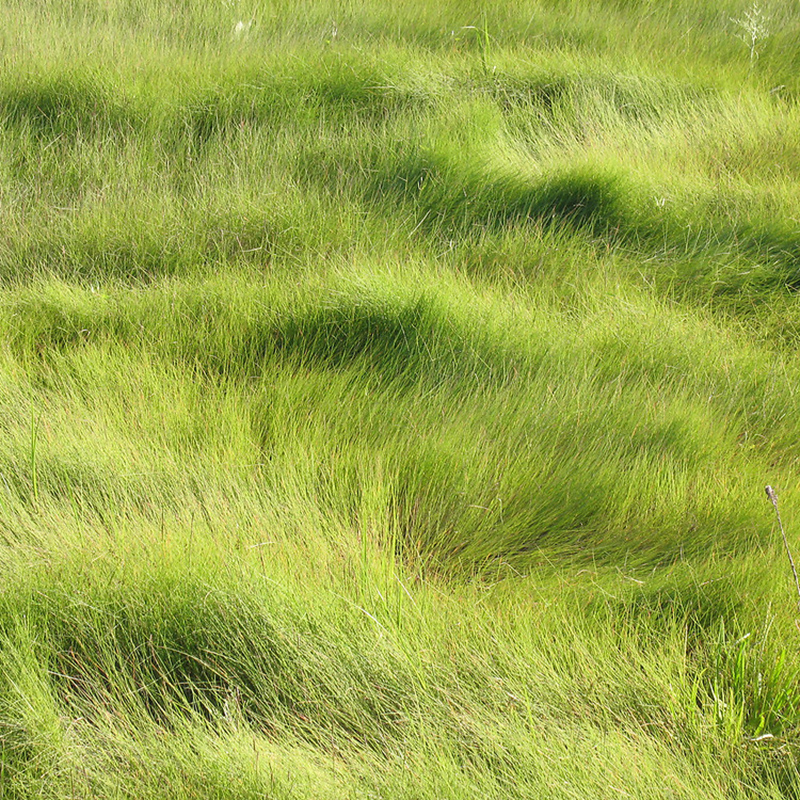
Saltmeadow cordgrass is typically found along salt marshes, from areas submerged in water to slightly upland locations. It grows best in full sun. It can grow up to three feet tall and is evergreen. Saltmeadow cordgrass provides nesting cover for waterfowl and song birds.
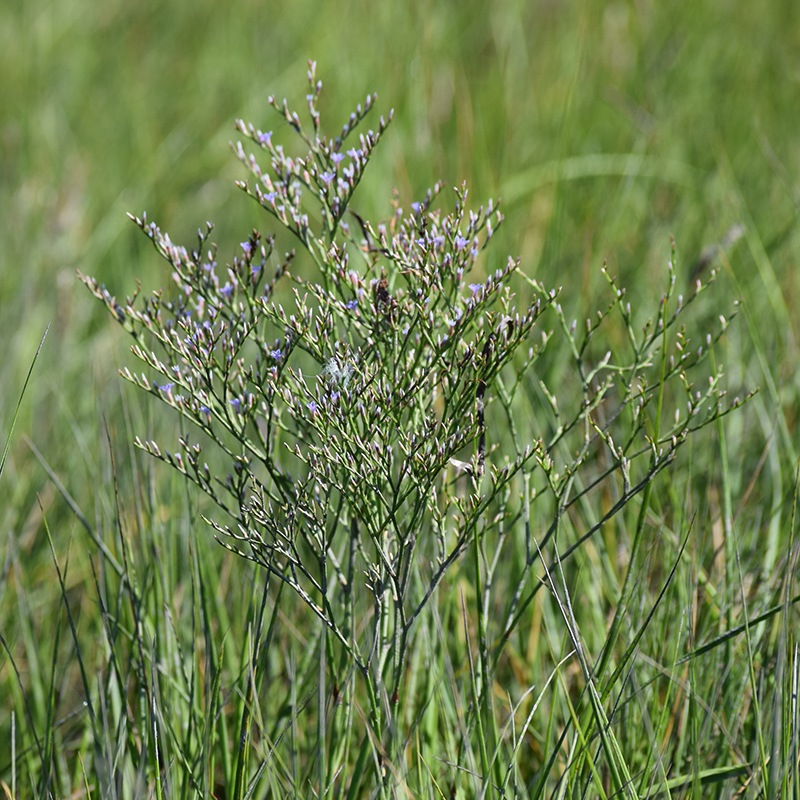
Sea Lavender is a species of flowering plant native to the eastern shores of North America. It is a slow-growing perennial herb found in salt marshes and other maritime habitats. Its showy flowers are blue to purple with white bracts that often last longer than the flower.
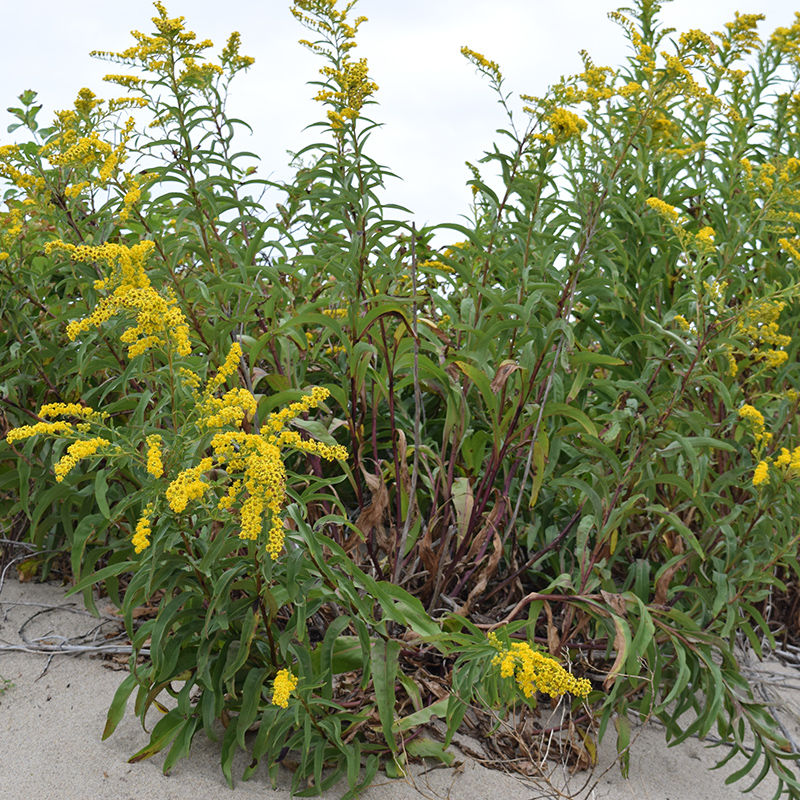
Seaside goldenrod is a succulent, herbaceous perennial that reaches heights of 4–6 feet. This species blooms in late summer and well into the fall, later in the season than most of its relatives. Its fruits are wind-dispersed achenes. They are often yellow and have sprouts of buds at the end of the short branches. It is highly tolerant of both saline soils and salt spray and is usually found growing on coastal dunes and in salt marshes.

Pycnanthemum tenuifolium, also known as Slender or Narrow-leaved Mountain Mint, has clusters of showy white flowers with faint lavendar spots that bloom in mid-to-late summer (July-September). It is best known for the multi-branching habit of stalks with very narrow, almost needle-like, silvery green leaves. This mint grows to be 2’-4’ tall and spreads rhizomatously to form small colonies. The plant attracts native bees, bumblebees, honey bees, and butterflies.
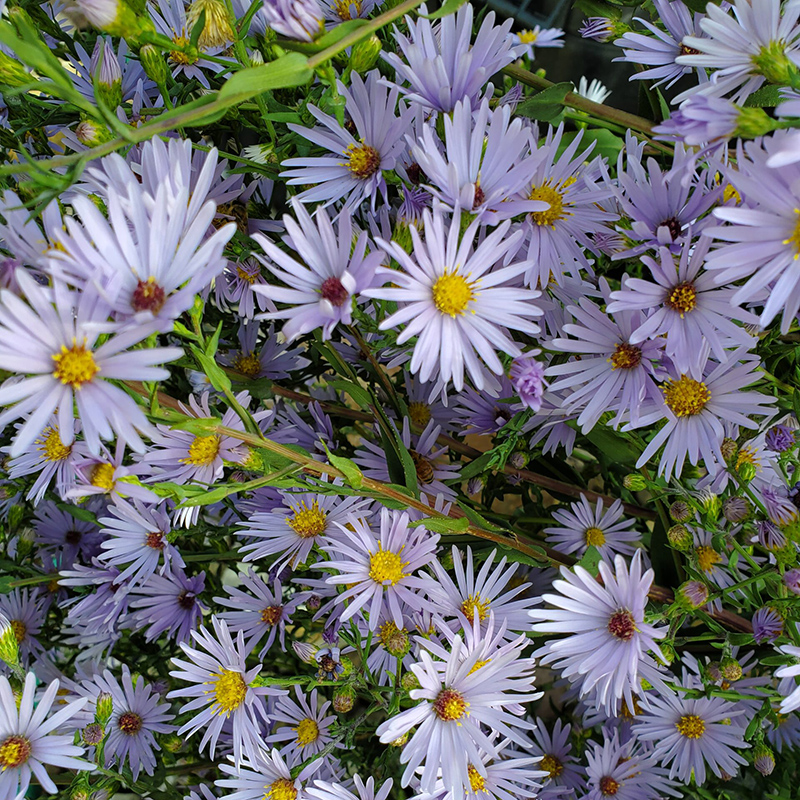
Smooth Aster is an herbaceous plant with an upright, clumping growth habit that grows to about 2-4 feet and can spread 2-4 feet. It produces numerous star-shaped flowers with lavender-blue rays radiating around a central golden-yellow disc. Blooming from late summer to early fall, the flowers are small, usually less than 1 inch across, but abundant. After flowering, it produces small seed heads that can be a food source for birds and small mammals. The flowers attract bees, butterflies, and other pollinators.
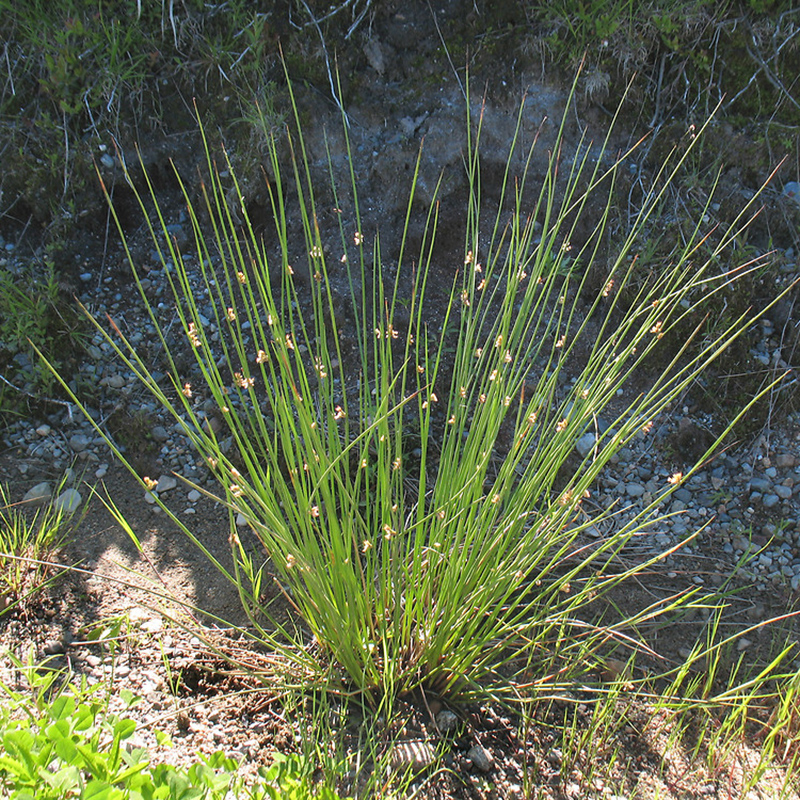
Soft or common rush is a perennial herbaceous flowering plant species that grows in wet areas. It grows in large clumps up to about 4 feet tall. The stems are smooth cylinders with light pith filling. The yellowish inflorescence appears to emerge from one side of the stem about 8 inches from the top. The stem ends there; the top part is the bract that continues with only a slight color band marking it from the stem. The lower leaves are reduced to a brown sheath at the bottom of the stem. The species provides wildfowl, wader feeding, and nesting habitats, and also habitats for small mammals. The root stalks are eaten by muskrats, and birds take shelter amongst the plant’s stems. Several invertebrates feed on it, including the rufous minor moth.
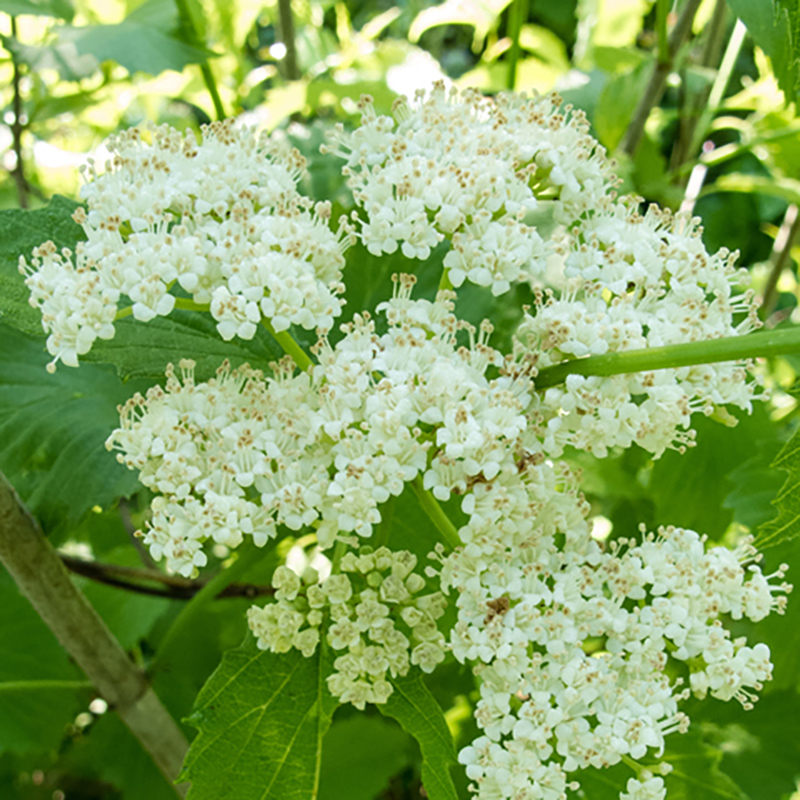
A 6-8 ft. shrub, sometimes taller, with multiple, erect-arching stems in a loose, round habit. White, flat-topped flower clusters are followed by dark blue berries. Lustrous, dark-green foliage turns yellow to wine-red in fall. A shrub with downy twigs, coarsely toothed leaves, and flat-topped clusters of small, white flowers.
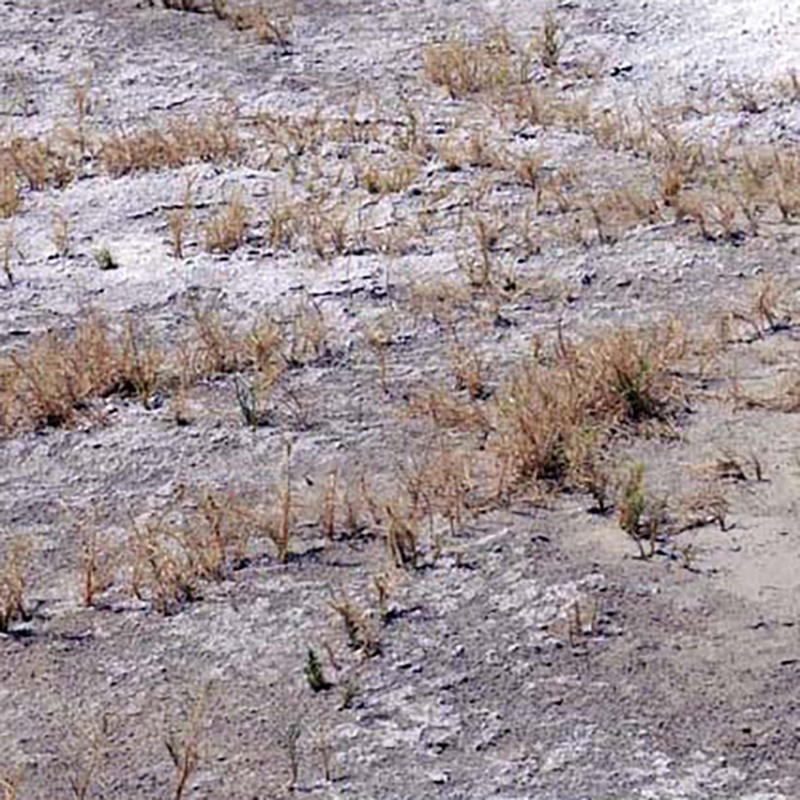
Spikegrass is a perennial that thrives along coastlines and on salt flats. The grass forms sod with its hearty root system. Its rhizomes have sharp points that allow it to penetrate hard soils and aerenchymous tissues, which allow it to grow underwater and in mud. This rigid, erect, warm-season grass forms dense colonies of dark-green, leafy stems up to 3 feet high. The seed head is short and made up of large, smooth spikelets.
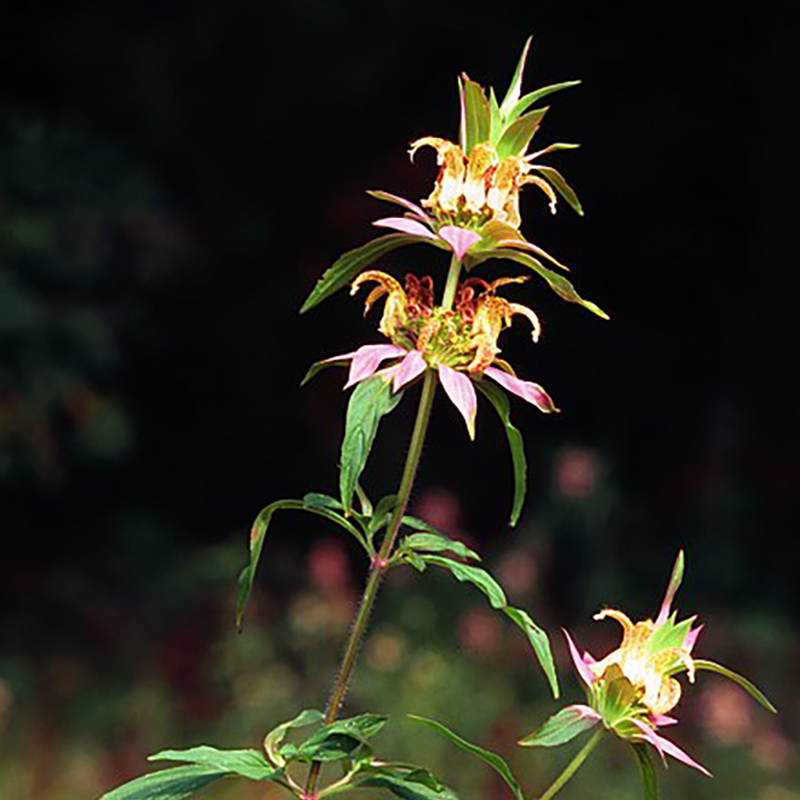
An aromatic, erect perennial ranging from only 6 in. to almost 3 ft. tall. Unlike the most familiar Monarda species with a single flower head on a stem, Monarda punctata has flowers stacked up the stem with bracts radiating from the stem under each flower. Varying in color from light pink to white, the bracts are ornamental and longer than the flowers, whereas the flowers (yellow with brown spots) are visible only at close range. It attracts pollinators in great numbers, especially wasps. Among the wasps it brings to the garden are beneficial predatory wasps that control grubs, pest caterpillars, and other harmful insects.

Swamp milkweed is a tall, herbaceous, moisture-loving perennial. It seeks sunny openings of swamps, marshes, and open areas along stream banks and ditches. This robust and erect stemmed plant grows three to five feet high and, like its common milkweed cousin, exudes a milky juice when broken. It has smooth, narrow leaves that are lance-shaped with sharp tips and occur in pairs. Sometimes, the leaf’s edges turn inward and upward, suggesting the prow of a ship. The fragrant clusters of flowers range in color from soft mauve to pink to reddish-violet. The fruit/seeds of the milkweed are attached to silky down and are encased in long one-chambered follicle pods. When the follicles dry, they split open, releasing the seeds with their downy parachutes to the wind. Swamp milkweed attracts butterflies, especially the monarch butterfly, which only lays its eggs on milkweeds.

Swamp rose-mallow is a cold-hardy perennial wetland plant that can grow in large colonies. The hirsute leaves are commonly deltoidal in shape with up to three lobes. Numerous forms exist in nature. It is a tall plant, with a height of 4-8 ft and flowers up to 8 inches across. Petal colors range from pure white to various pinks to deep red, and most have an eye of deep maroon. It is a larval host for the common checkered skipper, the gray hairstreak, the Io moth, and the pearly wood nymph.
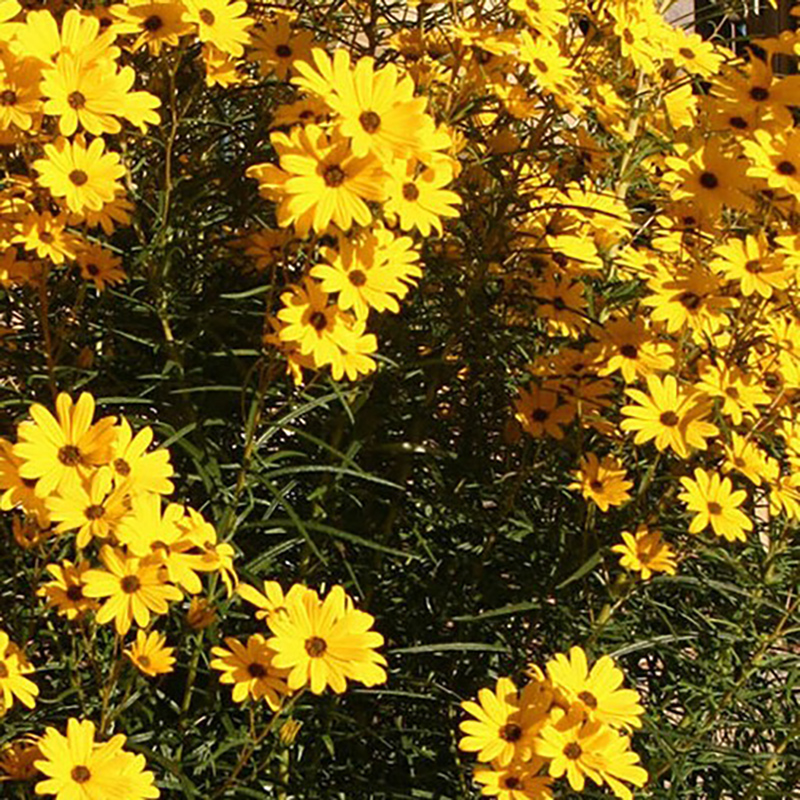
Helianthus angustifolius is a species of sunflower known by the common name swamp sunflower. Flowering begins in September or October and continues until frost. Golden brown seed clusters follow and remain into winter to feed the birds. Plants grow 5-7′ and up to 10′ tall with 4-6′ or greater spread. Leaves are long and narrow, up to 5.9 in long. It is a perennial herb, sometimes as much as 59 in tall. One plant can produce 3-16 flower heads, each with 10-20 ray florets surrounding at least 75 disc florets.
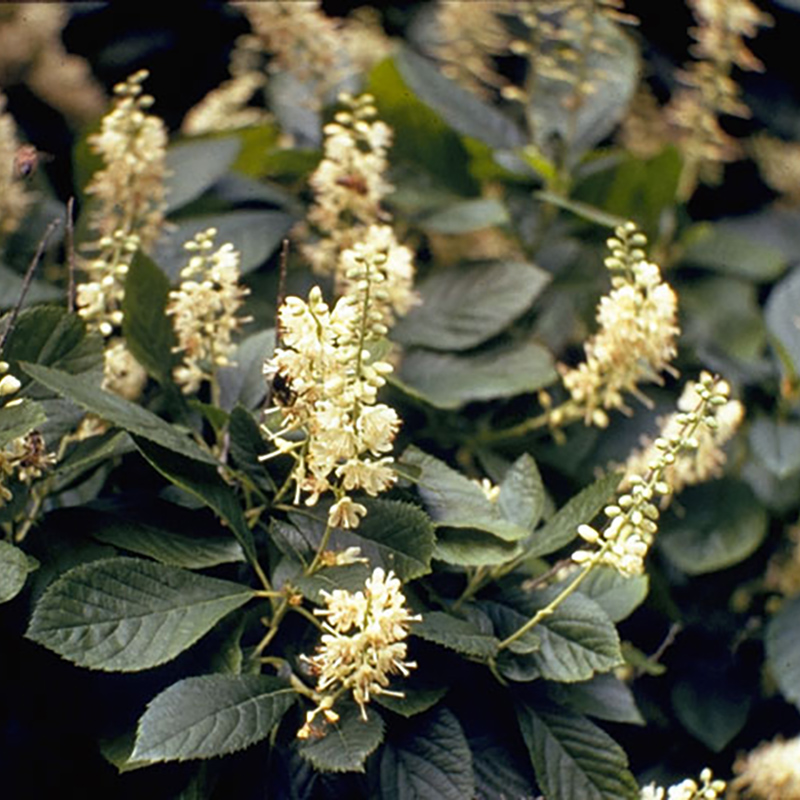
Coastal sweet-pepper or summer sweet is a narrow, 6-12 ft., deciduous shrub, which often spreads into mounded clumps. A tall, many-branched, leafy shrub with spike-like, upright clusters of fragrant white flowers. The shrub has erect, multiple stems; exfoliating bark; and simple, oval, toothed leaves which turn dull yellow to orange in fall. The dense, narrow, cylindric flower spikes are often clustered together at branch ends. Fragrant flowers are white and are followed by brown capsules which persist through winter.
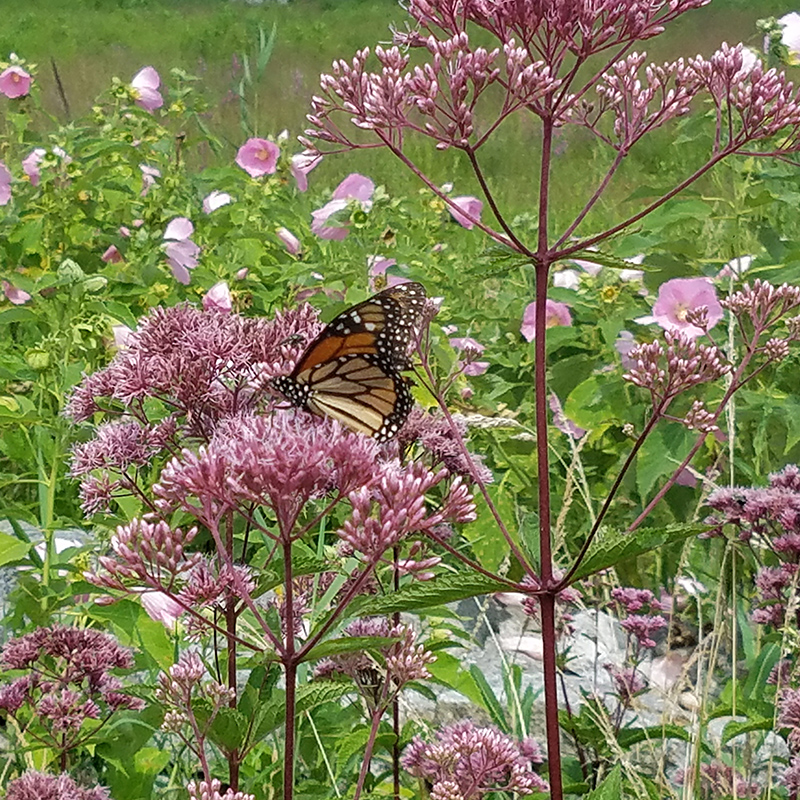
A butterfly favorite, its vanilla-scented flowers are irresistible for Monarchs, Swallowtails, and many other butterflies. It also attracts skippers, moths, and native bees. Moths of several caterpillars feed on the foliage. Sweet Joe Pye Weed matures at 4 to 7 feet in height and blooms from July to September. It has pale pink to pale purple flowers in large clusters and large leaves in whorls around the stem.
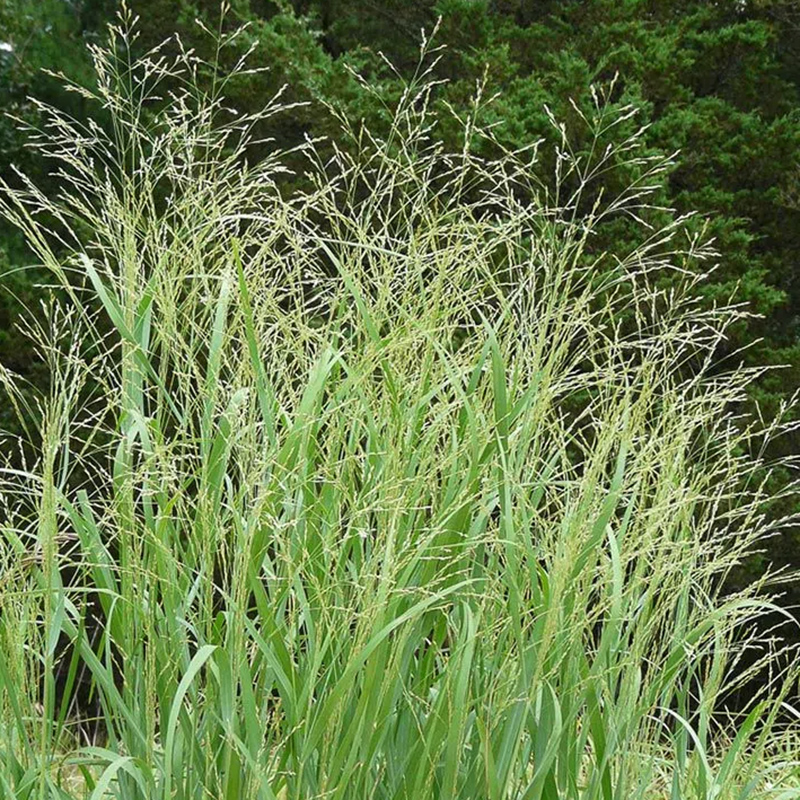
Switchgrass is a hardy, deep-rooted, perennial rhizomatous grass that begins growth in late spring. It can grow up to 9 feet high. The leaves are 12–35 inches long, with a prominent midrib. Its flowers have a well-developed panicle, often up to 24 inches long, and it bears a good crop of seeds. When ripe, the seeds sometimes take on a pink or dull-purple tinge, and turn golden brown with the foliage of the plant in the fall. Switchgrass is well known among wildlife conservationists as good forage and habitat for upland game bird species, such as pheasant, quail, grouse, and wild turkey, and songbirds, with its plentiful small seeds and tall cover.
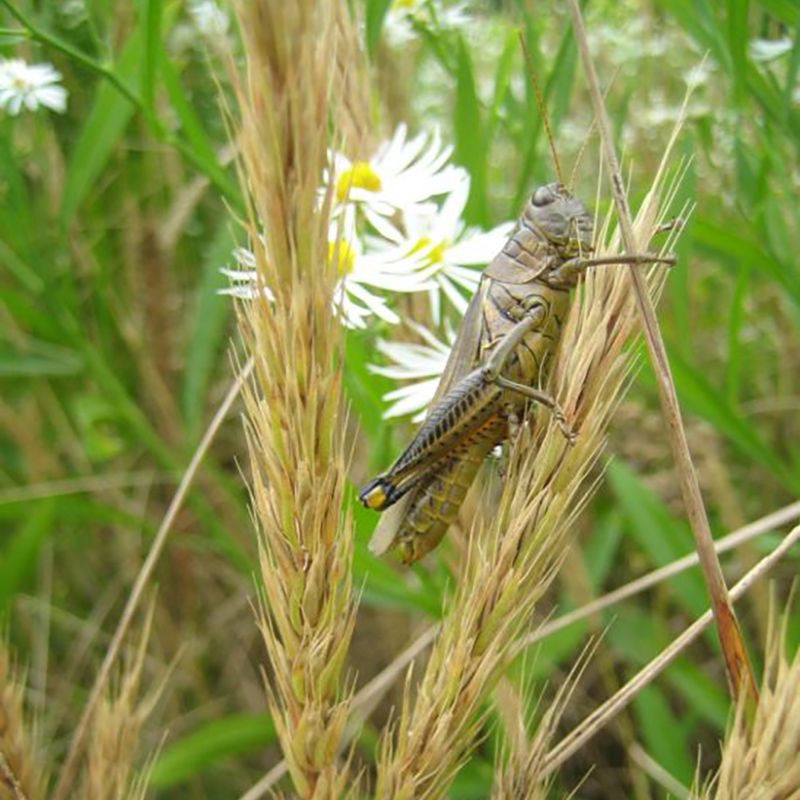
The plant grows in clumps up to 1 foot tall. The flower spikes rise up to 4 feet tall with bristly wheat-like inflorescences that sway in the breeze. They are followed by seed heads that mature to tan and continue to add interest to the plant into fall. It will freely self-seed. Various insects feed on common eastern wild-rye, ducks sometimes eat the seedheads, and geese feed on the foliage.provides shelter to small mammals and insects.
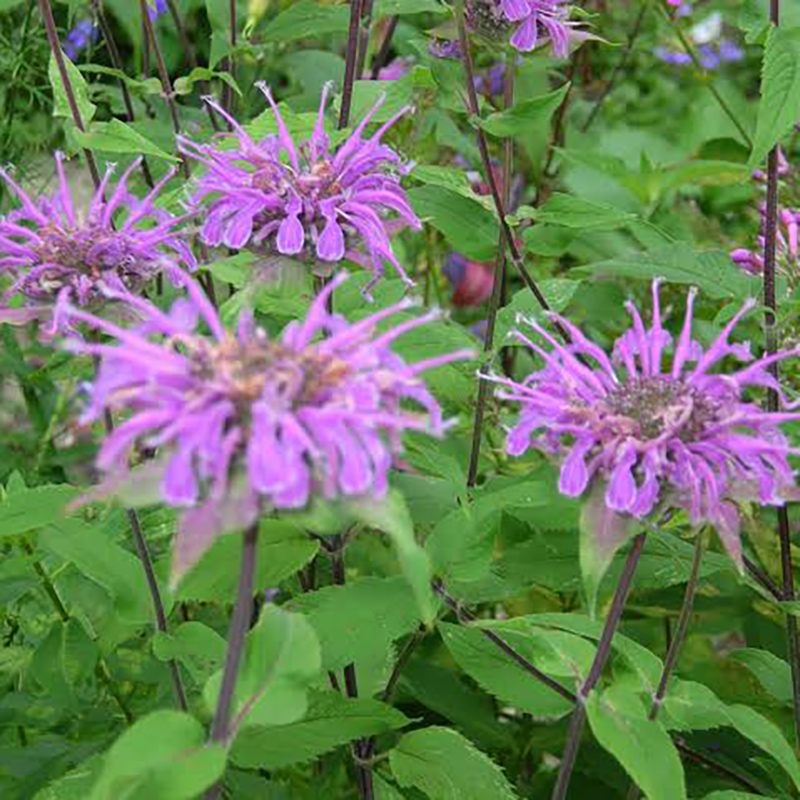
Monarda fistulosa is a clump-forming perennial up to 2-4 ft tall and 2-3 ft wide with masses of fragrant, lilac-purple flowers that bloom from mid-summer to early fall. It will expand into colonies from shallow, vigorous rhizomes. Its flowers attract butterflies, humming birds, and other beneficial pollinators.
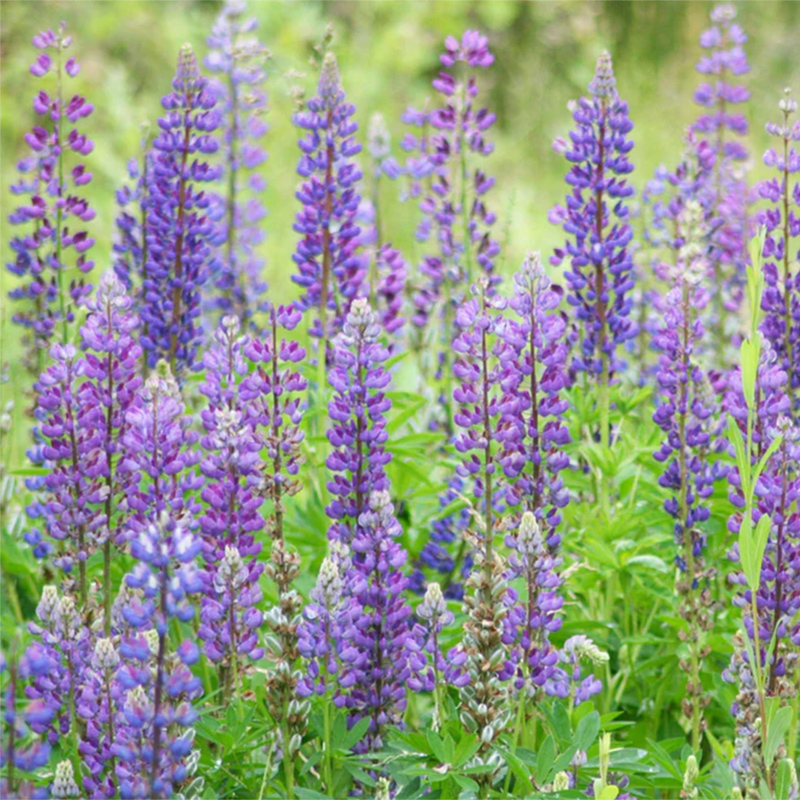
Wild, or Sundial lupine, is native to eastern North America but rare in New England. But in most states, recent declines have been documented, and few populations remain. It has large racemes of blue flowers, the leaves are made up of two or more leaflets and have smooth edges. Wild Lupine is used as food by the caterpillars of several Lepidoptera. Among these are the clouded sulphur, eastern tailed blue, gray hairstreak, silvery blue, wild indigo duskywing, frosted elfin, the eastern Persius duskywing, and the rare and endangered Karner blue, whose caterpillars feed only on the lupine leaves. Leaves that have been fed on by Karner blues have distinctive transparent areas where the larvae have selectively eaten only the green, fleshy parts. Birds and small mammals eat the seeds.
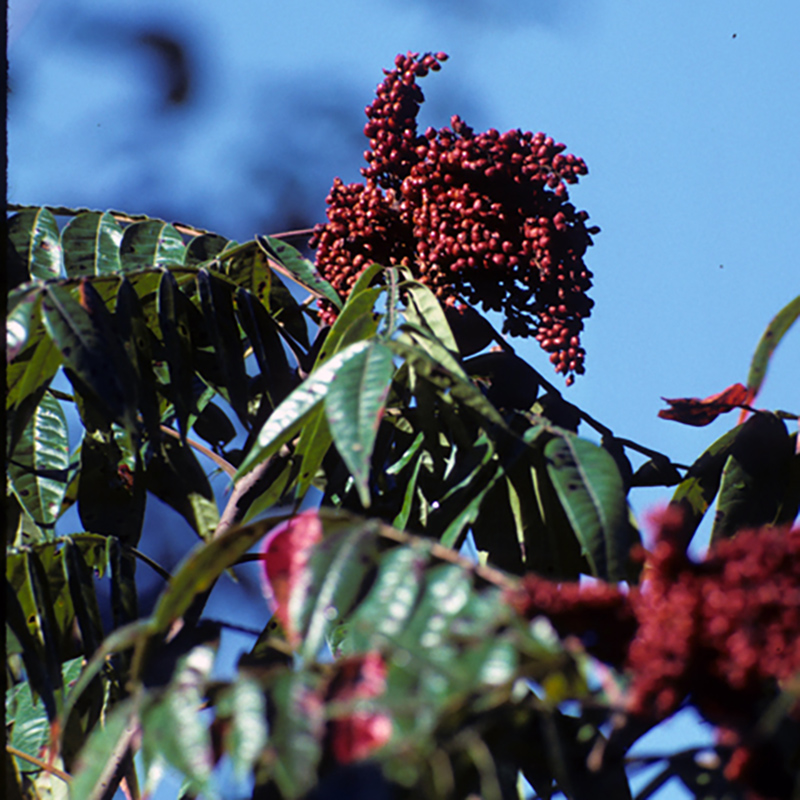
Winged sumac is a large, deciduous shrub or small tree, 20-35 ft. tall, with short, crooked trunks and open branching. Glossy, dark-green, pinnately compound leaves turn reddish-purple in the fall. Yellowish-green flowers are succeeded by drooping, pubescent, pyramidal fruit clusters which turn dull red and persist through winter. It is easily distinguishable from other sumacs by the winged leaf axis and watery sap.

